

Agate Fossil Beds National Monument
Nebraska
Produced by the
Division of Publications
Harpers Ferry Center
National Park Service
U.S. Department of the Interior
Washington, D.C.
National Park Handbooks, compact introductions to the great natural and historic places administered by the National Park Service, are designed to promote understanding and enjoyment of the parks. Each is intended to be informative reading and a useful guide before, during, and after a park visit. More than 100 titles are in print. This is Handbook 107. You may purchase the handbooks through the mail by writing to Superintendent of Documents, U.S. Government Printing Office, Washington DC 20402.
What was life like in North America 20 million years ago? Agate Fossil Beds provides a glimpse of that time, long before the arrival of man, when now-extinct creatures roamed the land which we know today as Nebraska. Part 1 of this handbook introduces you to the park; Part 2 brings life to the fossil specimens and examines the area’s geological and ecological evidence; and Part 3 presents concise guide and reference information.
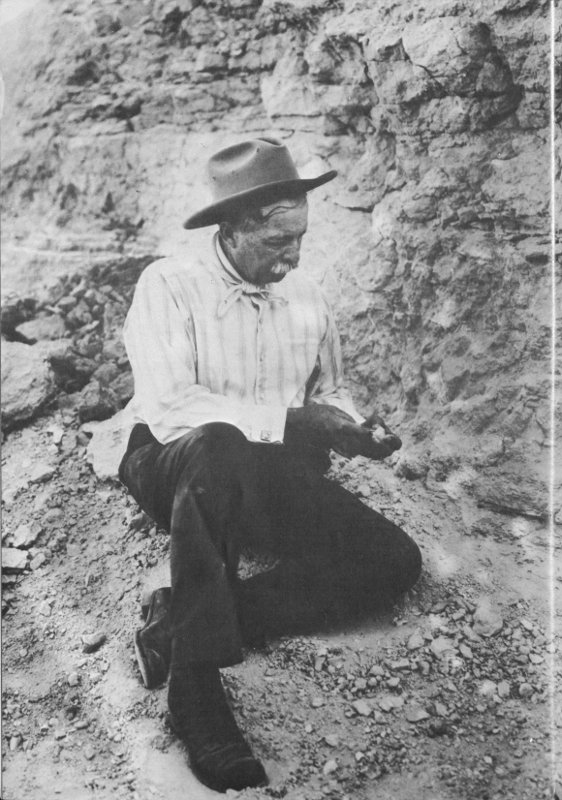
James H. Cook examines a fossil fragment at the quarries near Agate Springs Ranch about 1918.
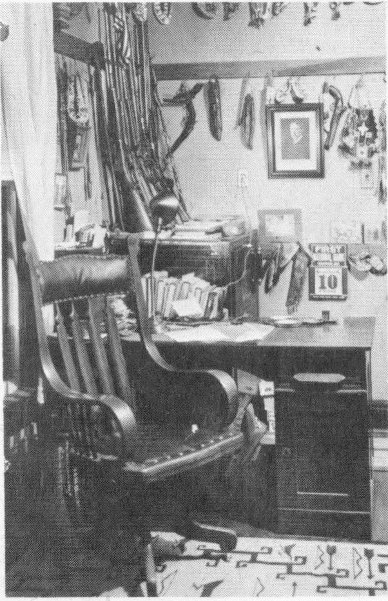
Besides fossils, Cook also collected Indian artifacts and kept many of them on the walls of his study in the ranch house.
Imagine that you are a healthy young man, raised conservatively in Michigan several years after the end of the Civil War. You are a skilled all-around hunter and trapper. The railroad has just spanned the continent, and stories of the West, its dangers, its people, and its opportunities come to you frequently. You and a friend decide you must see this land for yourself, and you save your money carefully against the day when you will be ready to go west. Around 1869, at age 12, that day comes.
At Fort Leavenworth, Kansas, you meet several cattlemen who tell you and your friend where to get work as cattle herders. Before many years have passed you have been a cowpuncher in Texas, you have fought Comanches, and you have bossed a ranch crew for a wealthy Englishman. You go on to fight the famous Apache Chieftain Geronimo as a scout with the U.S. Cavalry, and you befriend a famous Sioux chief, Red Cloud. You marry, buy a ranch in western Nebraska, and raise a family. And you become something of a legend in your own time, your ranch known for its hospitality to Indian, scientist, traveler—to one and all, rich or poor.
A movie script? Not at all—these are the essentials of the life of James H. Cook. Known as “Captain,” James Cook became the owner, in 1887, of the Agate Springs Ranch, founded earlier by his father-in-law. Under Cook’s watchful eye, the ranch prospered and became a second home both for the Oglala Sioux and for paleontologists bent on excavating the fossilized remains of the life of 20 million years ago, found here along the Niobrara River in western Nebraska.
This land, now encompassing Agate Fossil Beds National Monument, is punctuated with low bluffs ascending westward toward the Rockies. It is a land of sharp contrasts, of cool, inviting riverbanks and parched ridges, the most famous of which are the fossil-bearing Carnegie and University Hills. The surrounding grassy plains are a tapestry of wild grasses—prairie sandreed, blue grama, little bluestem, and needle-and-thread. The wildflowers lupine, spiderwort, western wallflower, sunflower, and penstemon add touches of blue, purple, orange, yellow, and red to the tapestry. In summer the dark green spears of the small soapweed, a yucca, dot the brown grasses of the hillsides. And just as they did more than 20 million years ago, cottonwoods and willows provide shade and shelter for birds and other animals along the river.

Professor Othniel C. Marsh, back row center, of Yale University and his students look as if they are equipped for a frontier hunting expedition. But instead of looking for live animals in the West, they were hunting for fossilized remains of ancient beasts. Marsh and his crews made many such trips, and it was on one early trip that Cook and Marsh met, in Sioux country.
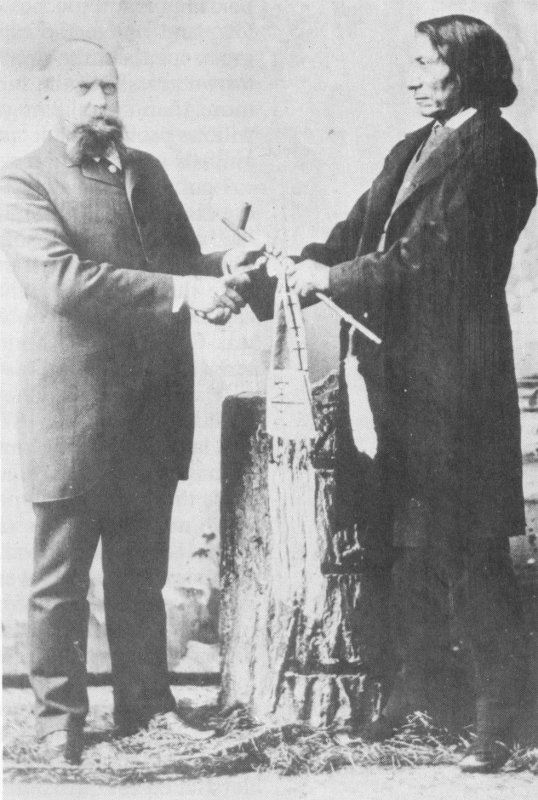
Professor Marsh and the great Sioux chief Red Cloud greet each other in New Haven in 1880.
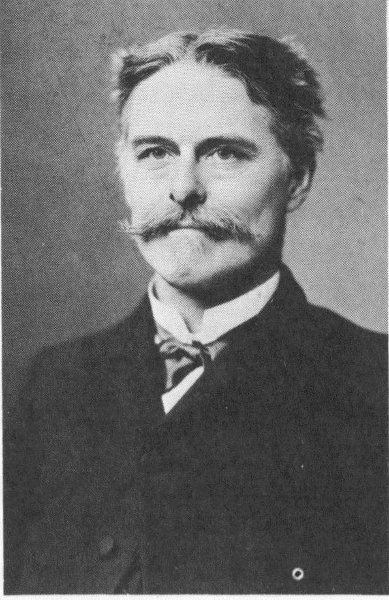
Professor Edward Drinker Cope competed with Marsh for the best fossils. He once made the mistake of reconstructing a skeleton hind end foremost; Marsh never let him forget it.
Looking out over the rippling grasses, you grasp the fact that Nebraska is larger than all of New England and feel the awesome spaciousness of the Great Plains. The word “distance” has a different meaning here than it does in the East. When James Cook came to the upper Niobrara River, the closest town was Cheyenne, Wyoming—more than 160 kilometers (100 miles) to the southwest.
It was there, in Cheyenne, that Cook met Dr. Elisha B. Graham in 1879, the year Graham selected this land for a cattle ranch as an investment and as a summer retreat for his family. Graham named the place the 04 Ranch, apparently because it is near the 104th meridian. Cook visited the ranch often in the early 1880s and courted Elisha and Mary Graham’s daughter Kate. They were married in 1886 and lived near Socorro, New Mexico, for a year before returning to Nebraska with their newborn child, Harold, and buying the ranch from Dr. Graham, who moved to California.
Cook began at once to make improvements to the ranch. He planted trees by the hundreds and carried water to them faithfully to get them started. As settlers failed to “prove up” their land claims over the years, he added new lands to the ranch and changed the name to Agate Springs Ranch in recognition of the native moss agates and the many springs in the valley. He and Kate raised fine race horses as well as cattle.
The period in which the Cooks took over the ranch was one of transition from the frontier days of migrations and Indian wars to more settled, orderly lives. Ranching and farming became the dominant mode of life in the eastern approaches to the Rockies. Even oil exploration played a part in the development of the land. The transition was a difficult one for many, Indian and settler alike.
In some ways Kate Cook represented both the old and the new in Nebraska. She was a fine horsewoman; one day she rode a bucking horse through 11 the streets of Cheyenne sidesaddle to win a bet for her husband. She was refined, too, having taught herself French so she could read French literature. Her mother, Mary Graham, became the first postmistress for the small community around Agate.
And James Cook was more than an adventuresome frontiersman. He was actively interested in community and national affairs and in current scientific questions. He became a patient, knowledgeable mediator between the Indians and the settlers, and he was looked upon by the Oglala Sioux as a friend and host, and sometimes employer.
The Cooks became involved in a great scientific enterprise quite accidentally around 1885, the year before their marriage. On a ride up the conical buttes not far from the ranch house, a glitter under a rock shelf caught Cook’s eye. They found fragments of bones scattered on the ground. At first they assumed the bones were those of an Indian. But Cook found instead “a beautifully petrified piece of the shaft of some creature’s leg bone.” They carried it back to the house but didn’t report the find until after they bought the ranch. Erwin Barbour of the University of Nebraska was the first to respond to their reports and in 1892 became the first professional geologist to visit the area and do some prospecting.
The Cooks’ discovery thrust them and their ranch into a subtle battle in the American West, a continuing struggle to find the best fossils with which to reconstruct the ancient past. For centuries it had been thought that life on our planet was only a few thousand years old, but by the late 19th century science had evolved beyond that point of view. Now paleontologists and their excavation teams were scouring the West in search of fossils that might provide clues to the beginnings of life.
The two most noted antagonists in this feverish search were Professors Edward D. Cope of Philadelphia and Othniel C. Marsh of Yale University. Cook knew them both, but the discoveries at Agate would wait for the next generation of scientists.
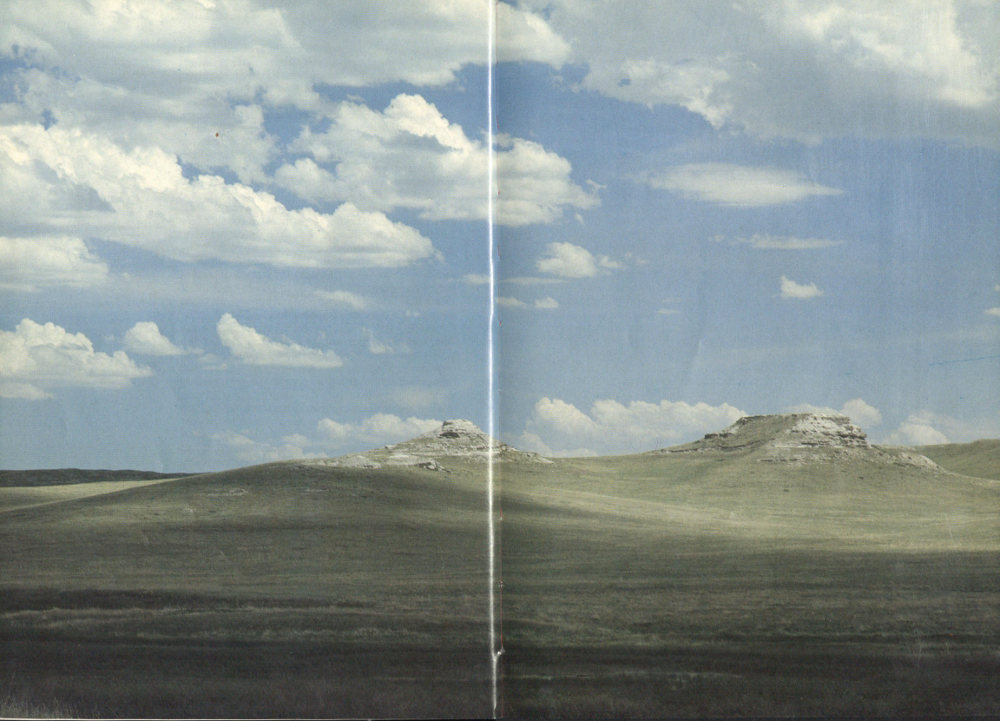
University Hill, left, and Carnegie Hill dominate the Niobrara River Valley. The hills received their names from the paleontological teams that worked them from the University of Nebraska and the Carnegie Museum.
Cook had first met Marsh in 1874. Marsh had just arrived in Oglala Sioux country to hunt fossils, but the Sioux Chief Red Cloud was suspicious. Red Cloud was convinced Marsh and his men were just another party of gold seekers. Cook, an able linguist, was then trailing cattle from Texas to the northern railroads and reservations. He persuaded Red Cloud that Marsh wanted only “stone bones” and averted a potentially disastrous clash. This incident led to a lifelong friendship between Cook and Red Cloud. And for Marsh this proved to be the last of many expeditions as he relied on others to send him specimens from likely fossil sites throughout the West.
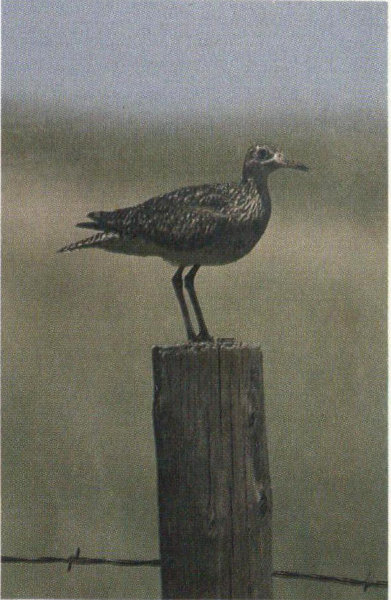
An upland sandpiper, one of many birds that can be seen at Agate Fossil Beds, perches on a fence post.
Professor Cope and his crews often worked the same localities as Marsh. Like Marsh, Cope tried to get the best specimens, and each occasionally outbid the other for them, leaving bewildered farmers and ranchers to puzzle over these men’s obsession with the past. Conflict also arose over the naming of animals previously unknown to science.
The hills of Agate Springs Ranch proved to be a rich archive of ancient life. Dr. Barbour and his students confined their efforts to what soon became known as University Hill. Thus began a quiet rivalry with Olaf Peterson and his crew from the Carnegie Museum in Pittsburgh, Pennsylvania, who worked what became known as Carnegie Hill. The most numerous fossils these teams found at Agate are the remains of the pony-sized rhinoceros Menoceras, but the site also is known for fossils of the gazelle-like camel Stenomylus, the early small horse Miohippus, and the corkscrew burrows of an ancient beaver, Palaeocastor.
Other distinguished scientists visited Agate over several decades. Among them were Henry Fairfield Osborn and Albert Thompson of the American Museum of Natural History in New York. The collections these men made at Agate are still being studied and exhibited.
James and Kate Cook’s older son Harold caught the fever, too. He became a trained geologist and in 1910 married another geologist, Eleanor Barbour, daughter of the distinguished Nebraska geologist. The new generation of Cooks continued the tradition of hospitality and scientific interest, encouraging further excavations of the fossil treasures of Agate. Perhaps Harold Cook’s greatest moment of scientific glory came in 1926, when he and other scientists participated in the finds at Folsom, New Mexico, which proved to be a turning point in the study of the human prehistory of North America. George McJunkin, a black cowboy, had spotted the ribs of an animal protruding from the banks of an arroyo. The Folsom spearpoint and the bones of an extinct form of bison found there indicated that humans had lived on this continent for more than 10,000 years, a startling revelation at that time though today scientists put the figure at more than 40,000 years.
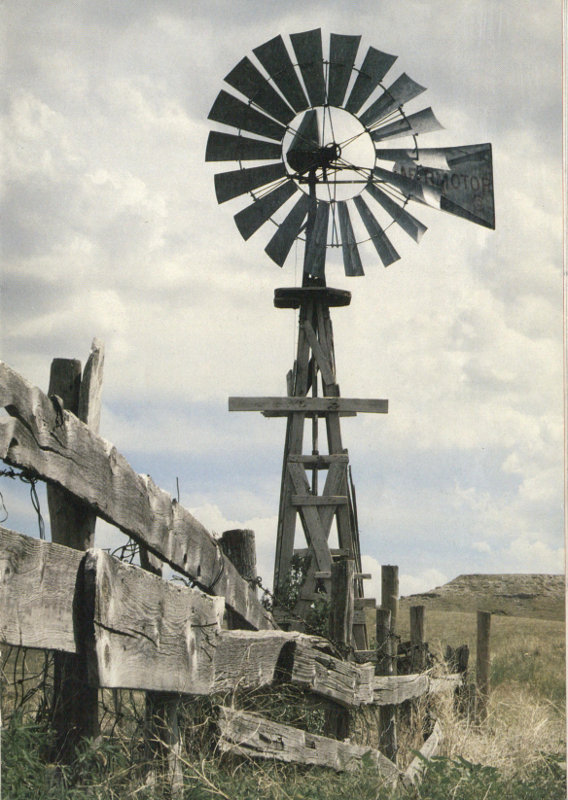
Next to the fence stands a windmill, which once provided water for excavation teams.
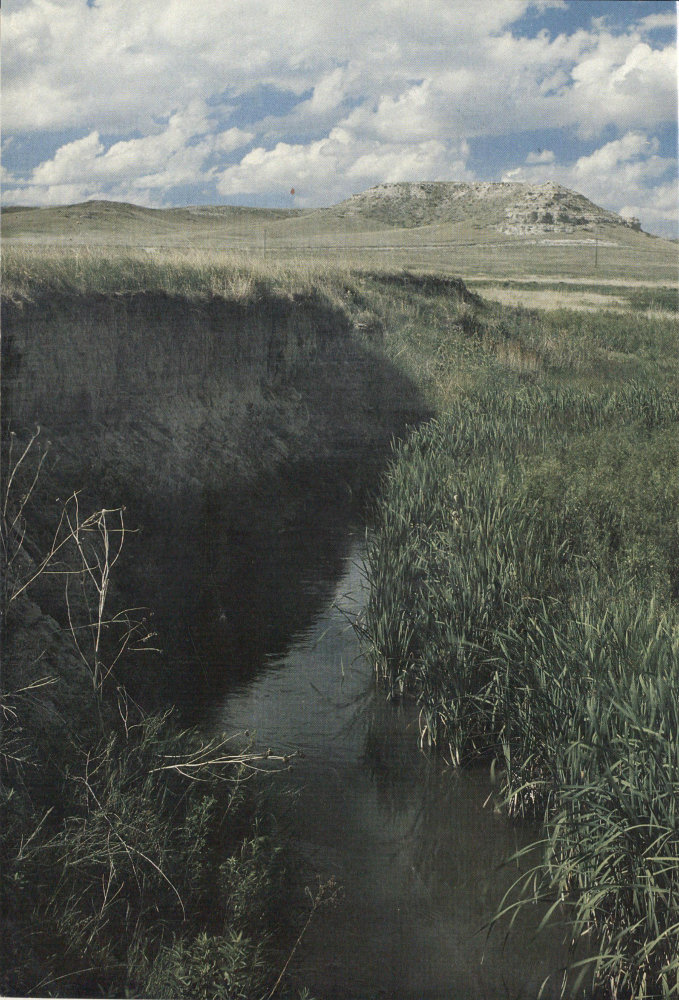
The narrow Niobrara River winds through the surrounding tableland, carving out bluffs and exposing occasional fossils.
In time the Cooks’ house became a repository for a substantial number of Indian artifacts and natural history specimens. On summer weekends and holidays tourists ventured out to the ranch to see the Cook Museum of Natural History. James Cook personally guided many through the collection, but usually the whole family participated, leading the curious through three rooms and a small hallway.
Harold Cook wanted Agate Springs Ranch to provide an enduring memorial to the ancient past. Soon after his death in 1962 his second wife, Margaret Crozier Cook, and friends began a campaign to add the fossil beds to the National Park System. Their efforts succeeded in 1965, when Congress authorized the establishment of Agate Fossil Beds National Monument.
Today you can walk about Carnegie and University Hills where the great digs took place. You can see a few exposed fossil specimens, and you can try to recreate in your mind the life and landscape of this part of Nebraska 20 million years ago. To help you do that, we have asked paleontologists James R. and Laurie J. Macdonald, in Part 2 of this handbook, to take you on a journey to the past and then examine the evidence.
Welcome to the worlds of past and present at Agate Fossil Beds National Monument.
Text: James R. and Laurie J. Macdonald
Illustrations: Jay H. Matternes
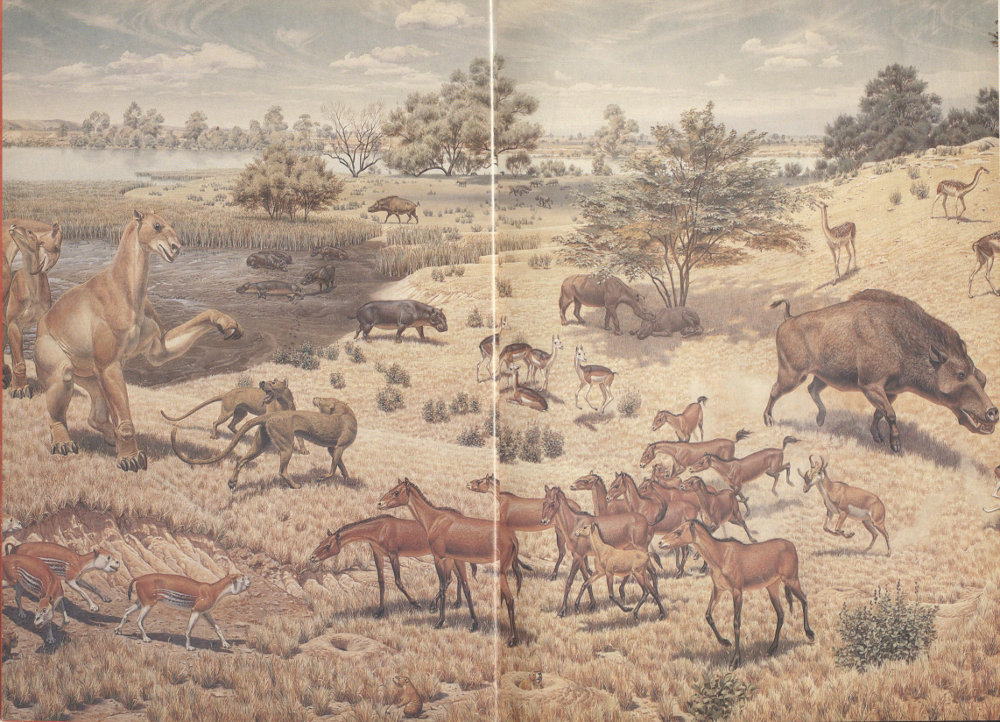
This mural depicts life in the Agate Fossil Beds area in the early Miocene Epoch, about 20 million years ago when the story on the following pages takes place. The painting is a composite of life at that time; if you had been there then, you would not have been able to see all of these forms of life together at any given moment! The original mural hangs in the fossil halls at the Smithsonian Institution’s National Museum of Natural History in Washington, D.C.
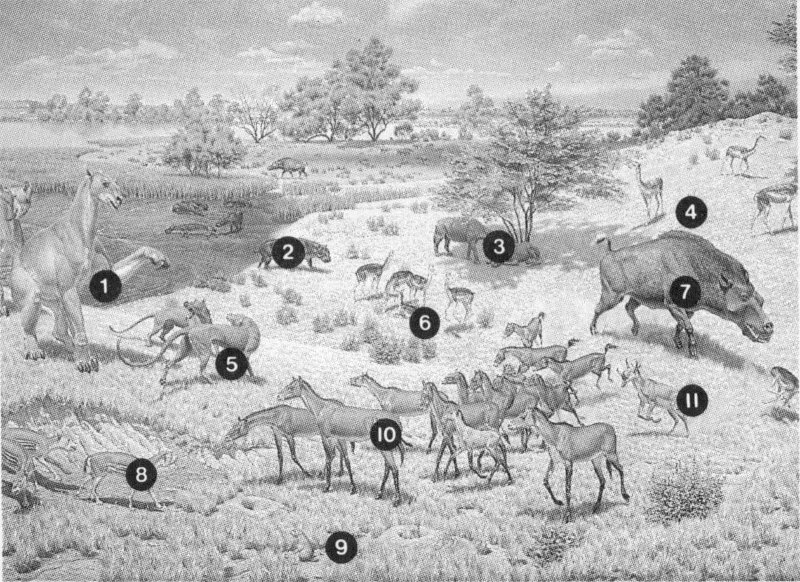
Come enter into our imaginations and return to a day along the Niobrara River in western Nebraska 20 million years ago. Let’s go back and have an imaginary look. To set the mood, think about the wild animal movies made in modern Africa during the last 40 years. Think of a land swarming with life, of extensive grasslands dotted with trees through which great herds of grass- and leaf-eating animals are wandering. Look sharply into the shadows under the trees and amid the high grass where the meat-eaters are resting or stalking their prey. When you have this picture of wildlife in mind we’re ready for our journey into the past.
Projecting ourselves back those 20 millions of years, we find ourselves in a landscape filled with animals. Some of the animals are not much different from those living today, but others are so bizarre that you may have a hard time believing they really existed.
Dawn is building a new day, and those animals which hunt and feed at night are disappearing into their lairs. There are so many kinds of livings to be made that the day isn’t long enough for all animal varieties to be about and active only in daylight. As the light spreads over the land we see that it is an open, sunny place of mixed grasses and trees—mostly grassland, but here and there single trees or small clumps not big enough to be called groves. We would call it a savanna.
A broad river runs through the land, and for lack of a better name we can call it the Niobrara or “Running Water,” the name given by Indians to the much smaller modern stream. This ancient Niobrara was a bold, wide stream with deep pools and sandbars. It was not cutting a valley as its modern counterpart is doing, but was carrying sand and silt down from the then-young Rocky Mountains. It sometimes flooded, and as it spread out over the wide, flat plain it deposited layers of sand and silt that geologists today call the Harrison Formation. The ancient Niobrara and other similar rivers spread the same sediments over nearby areas in eastern Wyoming and southwestern South Dakota. In the sediments, 24 paleontologists would one day find millions of bones.
Our ancient river was the center of life for untold numbers of animals. They lived in it, along its banks, in the willow thickets that grew on its more permanent sandbars, and on the broad, tree-dotted plains that stretched to the horizon beyond the river’s normal course. Great herds of small horses, rhinoceroses, camels, and other dwellers on the savanna came to water holes to drink and perhaps to wallow in the cool and refreshing pools. Although all else might be anticlimactic, let’s look at the rhinoceroses first.
We know that in the modern world rhinos belong in Africa and southeastern Asia, not North America, yet this continent was the major home of these strange beasts for millions of years. Rhinos did not become extinct in North America until about 5 million years ago, during the Pliocene (see geologic time chart on page 46). Along the ancient Niobrara the rhino herds are not made up of the giant mammals we see in zoos today. The ones we see moving slowly toward the river on this early Miocene day are no larger than big domestic pigs. They are the first among the rhinos to have horns—not one behind the other, but a pair near the end of the nose, side by side. To scientists today these rhinos are known as Menoceras. The name Diceratherium, once used both for these small rhinos and a larger type of ancient rhino, now refers accurately to just the large rhino.
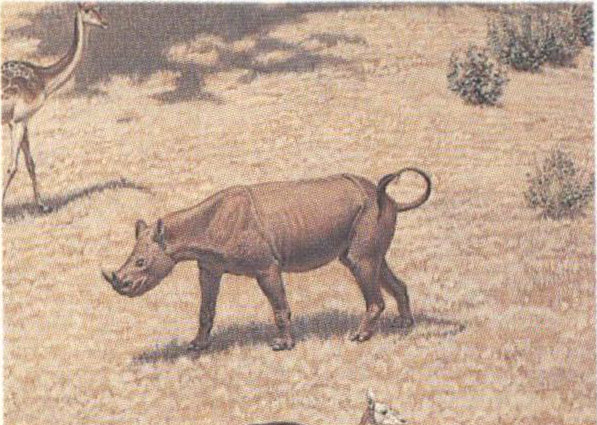
Menoceras
Look off to the south. There’s a herd moving slowly but purposefully down to its favorite watering hole. You can see that the males have the paired nose horns, and that the females, which are about the same size, do not. Trotting amid the herd are fat little colts whose seriousness of purpose belies their youth. The herd seems to be made up of about 50 individuals moving through the tall grass like a flattened dark gray cloud. Suddenly they are startled by a large cat or dog stalking through the grass, and all the males on the side nearest the enemy bunch together to face the hungry hunter. Most of the herd continues to flow across the plain, and when the danger is past the guardian males catch up in a lumbering gallop.
Finally the herd reaches the river and spreads out through the shallows. It is hot today, and the flies are biting even through the tough rhino hides. Many 25 of the adults go into deeper pools to roll and soak while the young drop their serious attitudes and frolic in the shallows.
As the day wears on, the herd leaves the river and feeds on the leaves and stems of scattered trees and willow thickets along the river. When twilight comes, the herd draws together, colts and females toward the center and bulls around the edges. After a period of milling and pushing, the herd finally beds down for the night, with only the perimeter guards moving around on the edges.
The daily routines of the other herds of grass- and leaf-eating animals generally follow somewhat different patterns from that of the rhinos. Of them, only the piglike oreodons wallow in the river. The others spend nearly all their time out on the savanna, coming to the river only at dawn or dusk to drink.
Oreodons were among the most abundant medium-sized animals of the Middle Tertiary. A strictly North American group, they have been described as looking like a cross between a sheep and a pig. As small as a house cat or as big as a domestic pig, these mammals reached a peak in abundance and variety between the Middle and Late Oligocene (though they are known from the Late Eocene through the Late Miocene). This peak probably has never been equalled by any other group of mammals in such a size range.
As we look out among the herds of animals dotting the plain, we can see only a few small bands of oreodons. There’s a group coming toward us now. These are some big, ugly ones with large triangular-shaped heads. The backs of their cheek bones flare out far to the sides, so that with their narrow snouts they are most peculiar looking. Their bodies are long and rather nondescript, and their legs are short but slender. This particular kind is known as Promerycochoerus (“before ruminant hog”) and is just about the largest of the oreodons. They are really a rare sight here at Agate. Perhaps the large herds of Menoceras fill their ecologic niche locally, and the oreodons have found they cannot successfully compete with the rhinos for food, water, and living space. After all, not everything can fit into Paradise.
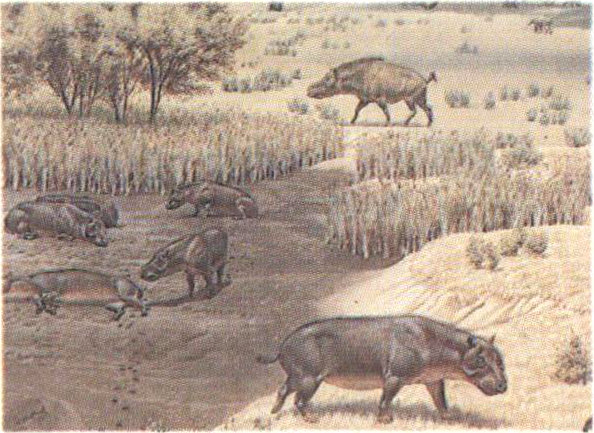
Promerycochoerus
Look to the northeast: there’s a herd of Miohippus (“Miocene horse”) wading into the river to drink and browse in the willows along its banks. Let’s walk 26 toward the herd slowly and quietly. We should take an especially good look at this herd—they are part of a doomed race! The genus Miohippus is making its last stand at this time. When conditions change, well adapted species may restrict their ranges to what is left of the old environment; they may adapt, if they are able, to the new conditions; or they may not survive if they cannot adapt.
Miohippus did all these things. Some species of the genus became extinct. Some evolved into something else. But the end result was the complete termination of the genus Miohippus as paleontologists recognize it. Much of the environmental pressure coming to bear on the genus Miohippus was a result of mountain building to the west. As the young Rockies rose, rain-bearing winds from the oceans far to the west were wrung of their moisture. This same circumstance makes the high plains a land of little rain today.
The scattered trees and groves we see from our vantage point of long ago will disappear and be replaced with a sea of drought-tolerant grasses. In effect, the savannas will give way to prairies. Miohippus will soon be yielding its place to descendants which can eat grass as a steady diet. Grass is much harsher on the teeth than the foliage that Miohippus eats. In eating grass, grazing animals pick up sand and silt enough to quickly wear away teeth designed for leaf-eating. The descendants of Miohippus will become better runners, too, with longer and more powerful legs. As the trees disappear there will no longer be friendly clumps of greenery to hide behind when hungry meat-eaters are on the prowl. From now on, fleetness of foot will be a most important factor in horse survival.
Miohippus will also give rise to somewhat larger forest horses that will survive on into the Pliocene in patches of woodland. They will be little changed except in size (some came to be nearly as large as the modern horse), and some of them will even cross the Bering Land Bridge into Eurasia. This is the last time, however, that we’ll see these primitive horses in large numbers here in North America.
There’s another herd of small horses moving across the plain toward the river from the south. These are feeding as they move across the savanna, eating both leaves from the scattered trees and grass 27 from the prairie. They seem to be enjoying their mixed diet and thriving on it, so they won’t be too badly hurt in the geologically near future when they have to eat mostly grass. This is Parahippus (“near horse”), a new kind of horse just recently evolved from Miohippus.

Parahippus
Parahippus is a horse of destiny. For a long time some individuals of Miohippus carried a little extra wrinkle of enamel on the crowns of their upper grinding teeth—and now the wrinkle occurs in all individuals of Parahippus. Because of it, Parahippus can eat grass without wearing out its teeth before reaching breeding age, making it possible for most individuals to reproduce before dying. The little wrinkle is passed on. It’s only a small advantage, but such is the stuff that survival and evolution are made of. Parahippus is the forerunner of a vast array of different three-toed, long-limbed prairie horses that will be the most numerous members of their family until nearly the end of the Pliocene. From one of their descendants will come the first one-toed horse—the direct ancestor of our modern horses.
More herds are moving in on the river as the morning grows. There’s a group of something very small moving through the tall grass, but it’s completely hidden. Only the swaying of the 60-centimeter-tall blades shows that a number of animals are hurrying toward the river. Now they’ve moved out into an area of cropped grass, and we can see a herd of the diminutive deerlike Nanotragulus (“dwarf goat”). Not a great deal larger than a house cat, these little “deer” have tall grinding teeth well adapted for grass-eating. Their ancestry goes back for millions of years into the Late Eocene, when some of their ancestors stood less than 15 centimeters (6 inches) high at the shoulder. But their entire family is soon to become extinct. They are part of the grazing community, although they eat leaves and softer vegetation just as readily. We call them “deer” because they look just like miniature deer, but the two families are really only distantly related.
As this group scampers toward the river, we can see that they have a peculiar crouching gait—their forelegs are so much shorter than their hind legs that they seem to be running continuously downhill. They are dainty little animals with small, delicate heads and short, slender limbs. They can bound swiftly 28 away if danger threatens, but they’d rather hide in the thick brush. A few of the females have fawns with them, tiny things less than 10 centimeters (4 inches) tall. Look at them all scatter! The shadow of a hawk has passed over the group, and in their fright they’ve dived for some nearby willows. Young Nanotragulus either learn to duck down at the sight of a passing shadow or they don’t get a chance to learn at all. This time they all got away, and the hawk will have to look elsewhere for a meal.
Buteos or buzzard hawks are common along the Niobrara in the Early Miocene, sailing on the warm updrafts on broad, short wings that let them ride the lightest airs. They swoop down on the mice and pocket gophers, young rabbits and beavers, baby “deer” and sometimes careless birds that live on this savanna. All manner of meat-eaters depend on the small animals for food, and the little Nanotragulus are most vulnerable as they move through the canopy of grass.
There don’t seem to be any other herds moving into view just now; but while we’re on the subject of birds, over there in that patch of short grass is a bird rarely seen in North America anymore. It’s a guan, a ground-living bird related to the grouse and sagehens. It must be far from home this morning; most of its time is spent in the thick brush farther back from the river. A heavy body and long neck and tail make this animal easy to identify.

Oxydactylus
Let’s look at some of the individuals and small groups that are moving or resting within view. The camels with the very slender legs and long necks are called Oxydactylus (“sharp finger”). They are browsing on the willows where the herd of Nanotragulus ran to hide. Oxydactylus is an important camel, standing about at the midpoint in the evolution of this North American family of mammals. The camels will remain stay-at-homes in the continent of their origin until they spread into Eurasia and South America at the beginning of the Pleistocene Epoch, some 17.5 million years after the rhinos died out at Agate. There are many species of Oxydactylus; the one we are looking at stands about 1.2 meters (4 feet) high at the shoulder. Notice that they don’t have humps on their backs; in this lush land there is no need to store fat against a time of possible starvation.
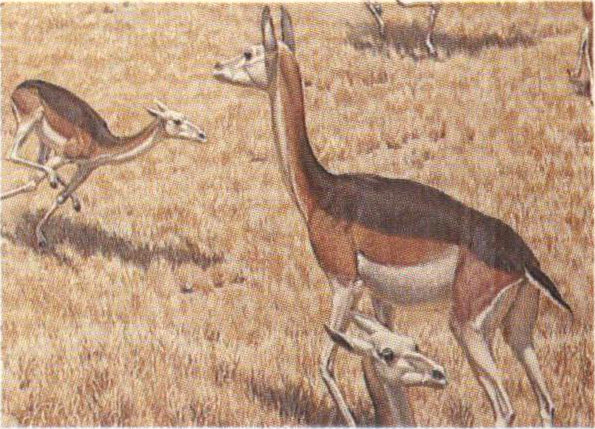
Stenomylus
Speaking of camels, here comes a herd of Stenomylus (“narrow tooth”) bounding through the tall grass on the south bank of the river. This is a strange little long-neck camel that strayed off the main line of the family’s evolution. Less than 60 centimeters (24 inches) high at the shoulder, it looks very much like the living African antelope called the gerenuk. Stenomylus, with its long and delicate legs and tall cheek-teeth, is perfectly adapted for living in and eating the abundant grass which billows on this tree-dotted plain. Yet many of the little Stenomylus are going to share a tragic time with hundreds of Menoceras only a year or so from this day we are visiting. Later, we’ll move ahead to that time so you can see that natural disaster, now preserved in rock, as it happened.
When you travel back 20 million years in time you would expect to find unbelievably bizarre animals. So far, we’ve seen some offbeat specimens, but there has been nothing really out of this world. Now, if you look to the north by the lone oak tree, you will see a real prize. Do you see that hulk stepping out of the shade? No, it isn’t the Dragon of the Ishtar Gate, though it might pass for a mythical beast. What a wonderful animal! A head like a large horse’s, a neck somewhat slimmer, long front legs, sloping back, short hind legs, and a little switch tail. Watch with your field glasses when it moves out onto the bare ground. See the feet? They don’t have hooves; each toe ends in a great curved claw! This is one of the fabulous chalicotheres, a relative of the horses and the rhinos. There were never very many of them living at one time, but the family lived in Eurasia from the Eocene, some 55 million years ago, through the Pleistocene; and here in North America from the Late Eocene to the Middle Miocene.
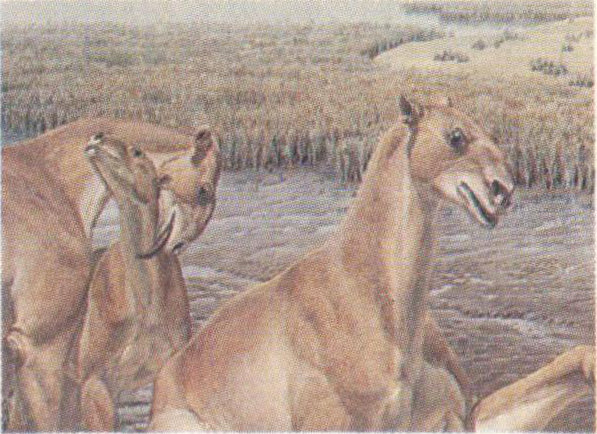
Moropus
This chalicothere is named Moropus (“sloth foot”), and it is little wonder that when paleontologists first discovered his foot bones (without an associated skull) they thought they had found the feet of a ground sloth. Let’s watch Moropus as it ambles slowly across the plain, its strange stilted walk a little like that of the modern giraffe. Other animals move aside as Moropus strides through the grass. He’s a browser, an occasional grass-eater, and even a digger of easily accessible roots and tubers. Like his cousins the rhinos, he isn’t at all bright, and he has a very 30 short temper. When he’s annoyed, he kicks out with those claws and every animal with good sense leaves him alone. He’s respected by meat-eaters and plant-eaters alike. He walks by himself and everything else detours around him.

Dinohyus
Look down toward the river, and we may see an exception. That two-meter (six-foot) high “pig” walking away from the river, covered with mud, is heading right toward the Moropus. His name is Dinohyus (“terrible pig”), and he’s just as short-tempered and stupid as Moropus. He looks like a giant peccary, but his size and over-large head give him away as an entelodont (“complete tooth”). These are pig-like animals, usually of large size, that aren’t related to the domestic pigs at all. Dinohyus’ skull is nearly one meter (three feet) long, and those tusks are as thick as a man’s wrist. Though we missed seeing him earlier, he must have been wallowing in the mud under the overhanging willows. Now he’s heading away from the river in search of lunch. He’s not very choosy about what he eats; it might be succulent leaves or fruits, or even the carcass of a dead animal. Dinohyus is an omnivore, eating almost anything that has nourishment.
Right now it looks as though he’s on a collision course with the Moropus. He’s seen the larger animal, has stopped in his tracks, and is pawing the ground with his front feet. Up goes his head—and listen to that roar! He’s getting a good temper worked up. Off he goes at a full gallop, right toward the Moropus. It’s hard to believe that an animal as big as that pig could charge so fast. And look at the Moropus! He’s finally realized in his dim way that he’s about to be attacked. Up he goes on his hind legs, holding his front legs out ready for a downward blow with all eight claws. But suddenly Dinohyus shifts his course just slightly, lets out another loud bellow as he avoids the Moropus, and thunders off toward the open prairie.
Dinohyus has a smaller relative around here somewhere, a little fellow just over one meter (three feet) high, called Entelodon. His head is long and low and has flaring cheekbones and bumps along the underside of the jaw like his larger cousin’s. Another pig that lives along the Niobrara is Desmathyus (“bond [filling a gap] pig”), a true North American pig or peccary. Its appearance probably wouldn’t surprise 31 anyone; it looks very much like the peccaries that live in the American Southwest today. Its distant cousin, the domestic pig, was domesticated in the Old World from a European species of wild hog, and it was spread throughout the world by European colonists. In America, peccary evolution has run a long and conservative path. This group has changed relatively little in the 35 million years since it first appeared in the Late Eocene.
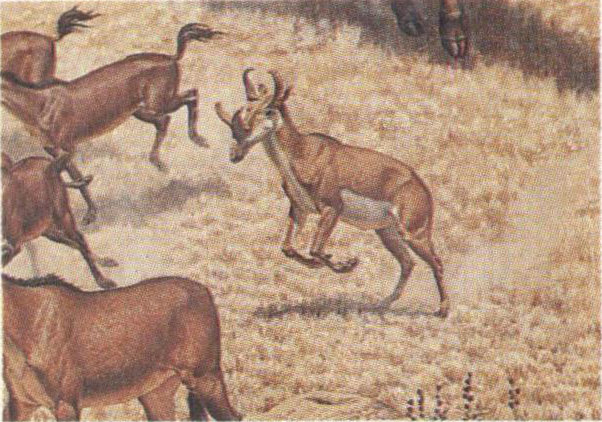
Syndyoceras
Now for another weird and wonderful beast! Trotting daintily out of a thicket on our left is a herd of something you might think were deer or pronghorn. But if you look closely you’ll see that they have two pairs of curving, unbranched horns on their heads, not the single pair of prongs you’d expect on a pronghorn. These are Syndyoceras (“together horn”), members of a family of mammals found only in North America and now extinct. Even on the Early Miocene day we’re visiting, they are scarce, moving only in small herds. The rear pair of horns is not remarkable, but the front ones, which rise from a large bump near the nose, curl up and away from each other, ending in blunt tips.
The first member of this family was Protoceras, which lived in the hills and mountains of western South Dakota during the Late Oligocene, just a few million years before the day we are visiting at Agate. Paleontologists have found battered scraps of its skeletons in the White River Badlands where perhaps they were washed by heavy spring rains running off the hills to the west. Protoceras had six bony bumps on its head that presumably bore short horns; one pair was over the nose, another was over the eyes, and a third was near the back of the skull. Probably it was the direct ancestor of Syndyoceras.
If Syndyoceras fails somehow to qualify as grotesque, let’s jump a few million years into the “future” and look at his Late Miocene descendant, Synthetoceras (“combined horn”). Here was an animal on a par with unicorns and cyclopses. Like Syndyoceras he had two tall horns at the back of his head; but something had happened to the curved ones on his nose. They had, during several million years of evolution, grown together into a single shaft and then spread out again to the sides and up. What a pity there were no little boys then, for here we have the world’s first and only self-propelled slingshot! 32 Tie a rubber band to the tips of his nose horns, fill your pocket with pebbles, and saddle up.
You may be wondering by now about the smaller animals—the rodents and small carnivores. We have not seen any of them so far. Most carnivores work at night, but there should be a few about. Down by the river is a pair of Oligobunis (“little cusp”) hunting near the water’s edge. They look something like modern badgers but are really more closely related to the weasels. If you look just to the right of the herd of Stenomylus we were following earlier you might be able to catch a glimpse of a stalking cat about the size of a mountain lion. It’s probably either an advanced Nimravus (“ancestral hunter”) or an early Pseudaelurus (“false cat”), but we’ll have to get a closer look before we can be sure. Whichever it is, it’s on the main line of cat evolution and will eventually end up in our familiar Felis and the other living cats. There should also be some sabretooth cats lurking about; they are found in nearby deposits of the same age, though not at Agate itself.

Daphoenodon
If you look very closely at the thicket just south of us on the hillside you can see several fox-like dogs hunting rodents. This Nothocyon (“false dog”) seems to have filled approximately the fox niche during the Early Miocene. Some coyote and wolf-sized dogs are in the area too. Daphoenodon (“blood-reeking tooth”) is about coyote size. Temnocyon (“cutting [tooth] dog”), is a little larger, probably substituted for the wolf in the local fauna, and is characterized by its heavy head and long, strong jaws. If we could get a close look at its teeth, we would see that they are like those of the Cape Hunting Dog living today in South Africa.
Let’s move away from the river a half-kilometer (0.3 mile) or so and see if we can find something different. That thicket ahead might produce a couple of rabbits. Look, there at the edge of the thicket: a Nothocyon has caught something. It’s a Meniscomys (“crescent mouse”), an early relative of the living mountain beaver Aplodontia. Today, a single species of Aplodontia, the last of the line, is found only in the mountains of the West Coast. It’s the most primitive living rodent, not related to the Canadian beaver, and sole survivor of a suborder which was the earliest rodent group to evolve. Meniscomys was one of the most prominent members of the group 33 during the Miocene. It had a round furry body, a round head with protruding incisors a bit like a true beaver’s, and no visible tail.
Watch your step. There is the mound of a pocket gopher. It is neither our familiar western gopher Thomomys (“heap mouse”) or the “eastern” pocket gopher of the Great Plains, Geomys (“earth mouse”), but an ancient relative, Gregorymys (“Gregory’s mouse”). It must be pretty successful as a burrowing animal, because we find it all over the western United States in the Early Miocene.
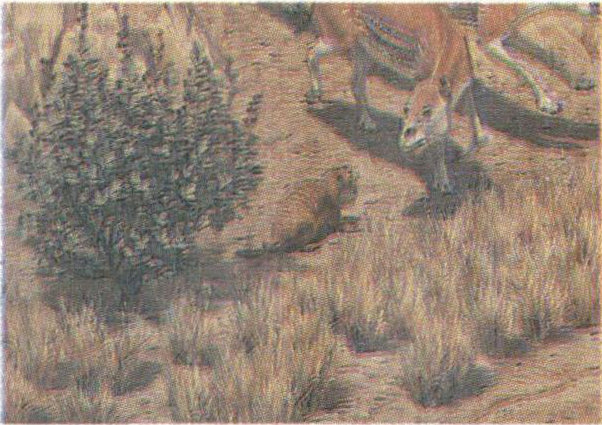
Palaeocastor
A hundred meters (300 feet) more and we’ll show you the surprise of the day. Here we are in what looks like a prairie dog town. But those aren’t prairie dogs. They’re a little larger, and quite unfamiliar by modern standards. Can’t guess what they are? These are beavers—Palaeocastor (“ancient beaver”) to be exact. Here in the Early Miocene of North America, beavers don’t build dams. In fact they live neither at the water’s edge nor, like muskrats, in the water. They dig deep, spiral burrows in well drained ground. Some of their burrows are 2.5 meters (8 feet) deep, but 2 meters (6.5 feet) is about average. Down and around and around the burrows go, like giant corkscrews, always ending in straight shafts slanting slightly upward so that living chambers will not be flooded by rainwater running down the burrows.
Paleontologists have called the preserved burrows “devil’s corkscrews”—Daemonelix—since the time they were first found. At first, scientists thought they might be holes left by the giant tap roots of some unknown plant. But when Palaeocastor skeletons were found in the bottoms of the spirals, almost everyone had to concede that they were truly beaver burrows. Admittedly, the skeleton of a Nothocyon was found in one burrow; but this predator probably followed a beaver home for supper and just stayed. Three other kinds of beavers lived around Agate in the Early Miocene, but their bones have never been found in the burrows. No one knows what they did for homes: perhaps their burrows were much shallower or were in the river banks where running water soon destroyed them.
Near the river bank in some soft sand is a nest of tortoise eggs. The hot sun has brought the babies out of their shells and they’re stumbling off in all 34 directions. Right now the biggest is only about twice the size of a silver dollar; but when they’re grown they’ll be about 60 centimeters (24 inches) across the shell, or perhaps even larger. They’re strict vegetarians, grazing and browsing on soft plants and leaves. There are probably some pond turtles around too, but we’ve never seen any.
A little farther up the bank, under the roots of that big walnut tree, is a rabbit’s burrow. Several Palaeolagus (“ancient rabbit”) live there with their many offspring. Although they look very much like cottontails, their ears are smaller and they haven’t the same leaping and running ability. They’d much rather hide than flee their enemies.
These dwellers of the savanna, common during the Miocene Epoch, comprise the major species found at the Agate Fossil Beds. Their discovery in the late 1800’s and early 1900’s was highly important to the young science of paleontology. In those decades of major discoveries, large gaps remained in the story of evolution. Quarries like those at Agate helped provide the missing pieces of the puzzle. In their time, the discoveries at Agate were an important contribution toward understanding the world far beyond the dawn of mankind.
Today, advances in paleontology still depend primarily upon major field discoveries, but paleontologists also make use of highly refined analytical and measurement techniques. Closely connected with paleontology are several other sciences, among them geology, zoology, and botany. The paleontologist, for example, must depend on geology to provide important answers about the age of fossil specimens. Fossil botanical specimens, in turn, can provide answers about animal diets and climate. Though paleontology may center on the study of fossil remains, it is an interdisciplinary science. This fact will become increasingly apparent in the following chapters, which reveal the strands of evidence used in constructing the picture of Miocene Agate.
Even in Paradise an occasional calamity can occur. Agate’s misfortune appeared in the form of a drought. To the west of the plain built by the ancient Niobrara River, the Rocky Mountains began to rise again. This renewed uplift, after millions of years of relative quiet, eventually led to an even drier climate and a replacement of the savanna with a landscape of unbroken grasslands from the mountains to the Mississippi River and beyond. Trees then could survive only on canyon slopes along the courses of the few large remaining rivers that crossed the plains. Those rivers flowed toward the central lowlands of North America, once an embayment of the Gulf of Mexico. This Mississippi Embayment, as it is called by geologists, extended as far north as the present location of Cairo, Illinois.
During the first rumbles of this upheaval there were occasional instabilities in the weather of the Great Plains. From the fossil evidence of Carnegie Hill, University Hill, and the Stenomylus quarry, we can see that drought touched the land.
What happens when disaster stalks the land? That question, so pertinent to an understanding of fossil deposition at Agate, can be answered best by looking at the normal scheme of life. Animal populations are cyclic, increasing rapidly to near the highest numbers which can be supported on available food supplies. If times are good, animal populations can be quite high. If the food supply decreases, massive dieoffs result. Successive cycles of plenty and poverty then produce high populations followed by dieoffs.
The fossil evidence suggests that a prolonged drought occurred during the Golden Age at Agate, resulting in death everywhere. The vast numbers of rhino skeletons preserved at Carnegie Hill and University Hill provide paleontological evidence that the drought must have lasted for several years.
Climates change slowly, and there are wet and dry cycles. Every rancher and farmer discovers this when he plows new land during a wet cycle, for sooner or later drier years catch up with him. He expects the optimum to be the standard; but he is badly hurt during average times, and really suffers when the 36 dry years come. It is the same with populations of wild animals. When the times are good and the grass and trees are lush, fat, and green, more of the young survive and the whole population flourishes. The plant-eaters expand their herds and the meat-eaters increase to keep up with the better food supply the plant-eaters provide. In each case the standards for survival are lowered, and the less than perfect can survive and in turn produce young of their own. But when the water fails and plants refuse to grow, the herbivores starve and the carnivore population in turn declines. Nature is indifferent—neither cruel nor kind. When times are bad every species is improved, for the strongest and most tenacious survive to reproduce themselves. There are benefits to hardship.
So it was at Agate only a year or so after the day of our visit. The river died for a while. As with many rivers much of its water flowed beneath the surface, through the sand and gravel of the bed. When the ancient Niobrara died there was still water moving through the sands and filling the low spots in its bed. Some animals could dig down to it and survive, others could stake claims to the diminishing water holes. So the thirsty, suffering herds of Menoceras went to the river and found no water. The strong held the water holes. The smart dug into the sand and made their own water holes. The rest died. They died by the hundreds, and thousands. Mixed with the carcasses of Menoceras were other victims: occasional chalicotheres, giant pigs, oreodons, cats, dogs, and a variety of equally thirsty smaller animals. Perhaps most of the animals went farther up or down stream, or perhaps they chose not to die at the river. Whatever the pattern of dying might have been, we know that Menoceras left untold numbers of skeletons on the broad, flat, and dry bottom of the ancient Niobrara.
Finally the rains fell in the mountains to the west. The river filled with water again and ran in sheets across the plain. At Agate the millions of Menoceras bones and lesser numbers of the bones of other animals were swept for a few hundred meters downstream and into some sort of backwater or river lake—possibly a great meander, or an oxbow lake. There, like a gigantic mass of jackstraws, they were piled in a tangled mat 30 centimeters (12 inches) 37 thick, covering an unknown number of hectares. All we really know is that they were moved far enough to get thoroughly jumbled, but not far enough to be badly broken or much eroded by the action of the water.
The mass of bones was soon buried by the sands and silts dropped by the reborn river, and by wind-carried debris swept off the parched land. Once buried, the bones were partially petrified by mineral water flowing beneath the surface. The land was built up a few hundred meters by sediments continually brought down from the mountains to the west. Eventually, continued uplifts of the Rockies and the Great Plains combined with erosional cycles to leave the modern Niobrara River. The two erosional remnants known today as Carnegie and University Hills were produced by the cutting of the modern river system. On the sides of these hills were exposed the tangle of bones which marked the site of ancient tragedy.
But this wasn’t the only scene of mass death to be preserved here in the fossil record. A few kilometers away an earlier drought took a toll of many other animals. The little gazelle-like camel Stenomylus tells the same story in scores of skeletons east of the Menoceras burial ground.
These graceful little camels may have died at the edges of their vanished water hole. The skeletons are mostly undisturbed except for a few pulled apart by meat-eaters. Scores of their dried out, mummified carcasses were buried about the same time as the rhinos on the river’s dry bottom. Like the Menoceras, the camels lay there for millions of years, intact in their death poses, the muscles in the backs of their necks pulling their heads back sharply into an unnatural position. There they lay until men discovered them.
Our imaginary journey into the past has reached its end. We have seen a day at Agate as it might have been 20 million years ago. We have watched the animals going about their daily lives during times of plenty and have seen it as it was later, when death’s heavy hand left a magnificent fossil heritage. This unique place is a window into the past, a window through which we can look back at any time and observe life at Agate millions of years ago.
The first fossils were collected in volume in 1904 by Olaf Peterson of the Carnegie Museum in Pittsburgh. Excavations have continued, off and on, to the present. As early as 1892, Erwin Barbour’s student F. C. Kenyon had retrieved a few bones from the site but their significance was overlooked. Rancher James Cook first picked some up in the 1880s and may have first noticed such deposits, without particularly recognizing them, in the 1870s.
Other institutions soon joined Carnegie in extracting slabs of the great Menoceras bone-bed, and occasional Moropus and Dinohyus specimens. The University of Nebraska opened a new quarry in 1905. Henry Fairfield Osborn, president of the American Museum of Natural History and one of the greatest popularizers and exponents of evolutionary science, and his chief preparator Albert Thomson began work in 1907. F. B. Loomis of Amherst College discovered the nearby Stenomylus quarry the same year. Yale University’s R. S. Lull soon followed.
From 1911 to 1923 the American Museum became the main excavator at Agate, but increasingly their attention was drawn elsewhere, including the later Miocene Snake Creek Beds 20 miles to the south. There, for awhile, great excitement centered around a worn tooth thought to be from an early human ancestor until the tooth was proven to be from an ancient peccary.
Until 1981, only occasional excavations for bonebed slabs and Stenomylus marked the next 50 years. Then, Robert M. Hunt Jr. of the University of Nebraska reopened the main quarries and a little-known side area, and found evidence of an extensive carnivore den of the beardog Daphoenodon.
In some cases, individual fossil bones were removed one by one, a very slow and painstaking process but when possible large blocks of fossil-bearing sediments were removed and shipped to laboratories for cleaning and analysis. The tools, chemicals, and special conditions necessary to extract the best specimens and most complete information are available only in a laboratory such as the one which is shown on pages 40 and 41 at the Carnegie Museum in Pittsburgh, Pennsylvania, in 1905. Slabs from Agate Fossil Beds were taken there so paleontologists could examine the evidence and figure out the past.
See pages 86-87 for a listing of museums with specimens from Agate Fossil Beds.
 39
39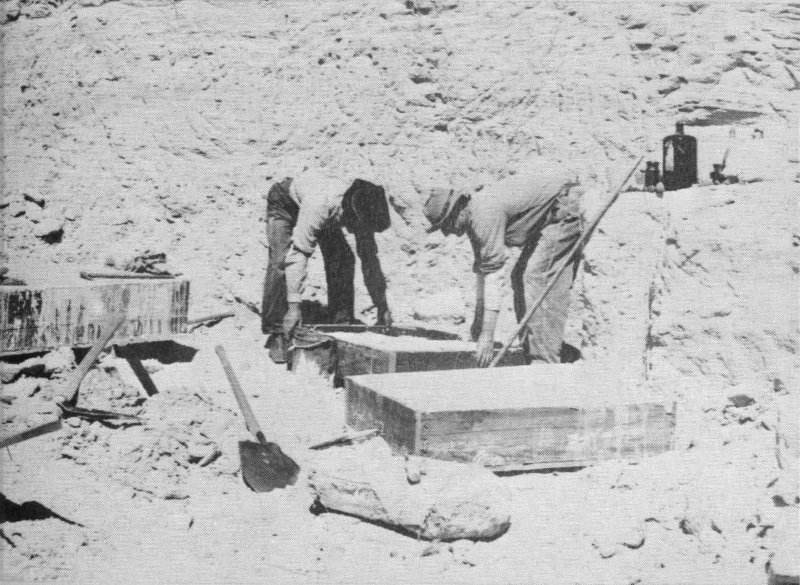
Members of Peterson’s crew built a box around a slab in the Stenomylus quarry around 1908 in preparation for shipping to the Carnegie Museum.
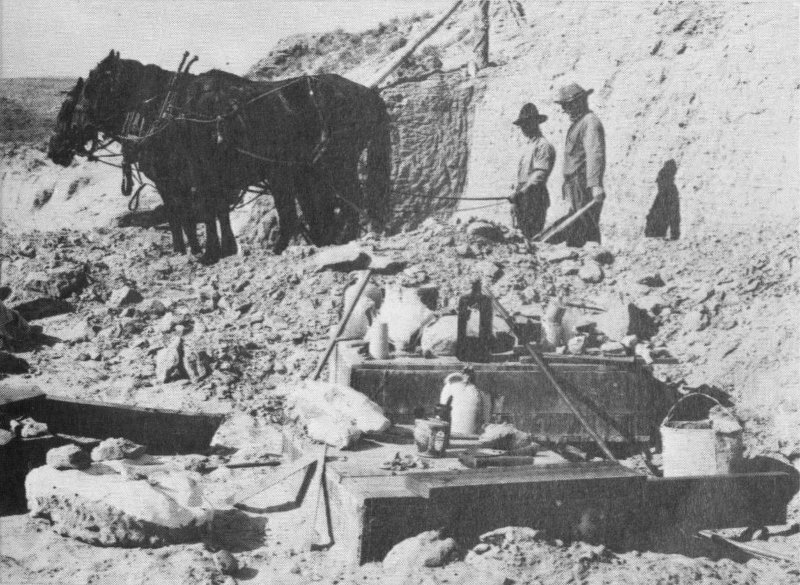
With a team of horses, O. A. Peterson’s field crew moves dirt out of the Stenomylus quarry around 1908. The boxes in the foreground are resting on the quarry’s lower bone layer. Several specimens to the left have been strengthened with plaster for shipment to Pittsburgh.
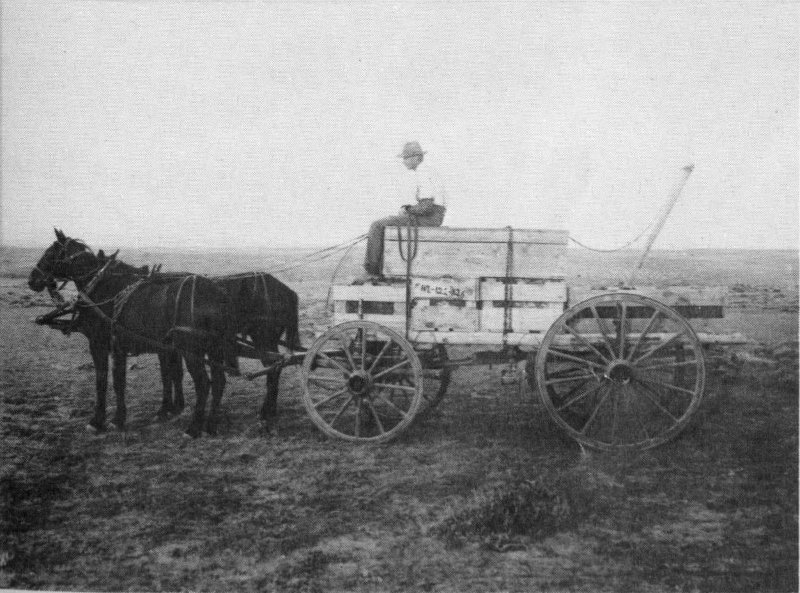
Crates of prepared specimens had to be taken to Harrison, 37 kilometers (23 miles) north of Agate for the rail trip to the East. Note that the wagon is just a flat platform and that the driver is using the largest crate as a seat.
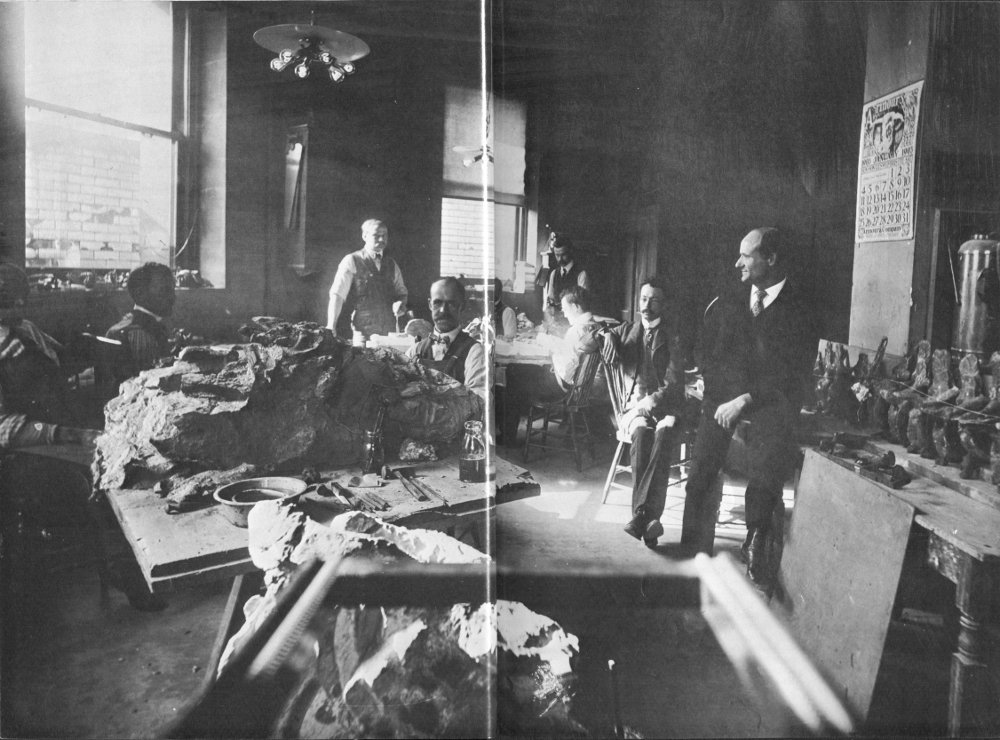
Paleontology is the study of ancient life through the fossil remains of that life. Today, there are thousands of museums, societies, professional groups, and academic institutions around the world devoted to this study. Fossil remains are still being dug out of the ground in a number of localities, such as Dinosaur National Monument in Utah, but by far the great bulk of fossils now being studied were excavated during the last 100 years.
There are now about 250,000 known separate species of fossil plants and animals. Biologists are still working to explore, find, and classify all living species; they estimate that 4,500,000 species of plants and animals are now living at our own brief moment in the nearly five billion years of our planet’s history. As you can see, the fossils now known represent only a tiny fraction of all the plants and animals that have ever lived. Yet a great deal is now known about even the simple forms of life more than three billion years ago.
How has this come about? What has happened since the days of our great-grandfathers to cause this vast increase in knowledge? Men must have picked up and discussed fossils for tens or perhaps hundreds of thousands of years. We have no way of knowing what the earliest men thought about them. Their significance has been revealed slowly in the way we tend to look at time, but perhaps not so slowly when we consider how short a period man himself has been on Earth.
Lucretius, a Roman writer of the first century B.C., thought that the Earth was very young. He interpreted the fossils known to him as the remains of monsters that had grown out of the Earth just after it came into existence. Evidently he had seen partial fossils and believed them to be whole, because he postulated that the Earth had brought forth creatures that lacked one or more limbs or other body parts. Lucretius assumed, as have many others, that the varieties of animals he knew of were fixed for all time and did not change. But he did recognize the principle of evolution, that things change as time goes on, in his description of human history.
Lucretius described four ages of human life, progressing from early hunters up to the highly civilized life he knew under the Roman Republic. His work was rediscovered during the European Renaissance, when scholars once again began to inquire into the nature of seemingly inexplicable things like fossils.
Toward the end of the 18th century the confusion over the importance of fossils and their relative antiquity forced a scientific showdown. For hundreds of years, fossil bones of extinct animals unlike any ever seen had been turning up, often with tools nearby that appeared to have been shaped by human hands. A growing feeling that the Earth and therefore the fossils were very old indeed was a topic of frequent discussion in Europe and in the New World, despite the assertion by Archbishop Ussher a century earlier that the Earth was not quite 6,000 years old.
Explorers and scientists had found fossils in deep layers of rock widely separated by other layers of rock, leading many of them to conclude that now-extinct forms of life had existed before the Biblical flood. A pioneer French paleontologist, Georges Cuvier, tried to solve this dilemma in the late 1700s by postulating that there must have been several worldwide floods before the one described in the Christian Bible. Finally, this solution collapsed under the weight of new evidence as more and more studies proceeded.
In the 1830s an English geologist, Sir Charles Lyell, popularized the principle of uniformitarianism—the idea that processes we observe now, such as the steady erosion of mountains, the gradual buildup of silt as sediments in rivers, lakes, and oceans, have always occurred since the origin of the Earth. This, he then reasoned, meant that the Earth must be many millions of years old at least, instead of merely a few thousand years old.
A wave of interest in fossils and their antiquity swept communities around the world in the 1840s and 1850s. Americans interested in science from Thomas Jefferson on had advocated the collection and study of fossils, and a feverish race to build up study collections got underway that lasted into the 20th century. Today, scientists believe the Earth is more than 4.5 billion years old, its life more than 3 billion years old.
43
Karl Von Linné, 1707-1778, is known as Linnaeus after the Latin form of his name. A Swedish botanist, he established a hierarchical system for classifying plants and animals that is still in use in a modified form. His organizing principle was the degree of complexity of the organisms he studied. This resulted in a system with seven levels: Kingdom, Phylum, Class, Order, Family, Genus, and Species, in descending order from the broadest category to the most specific. Students remember the system by the sentence “King Philip Crossed the Ocean For Good Soup.” Without realizing it, Linnaeus prepared the ground for the evolutionists, who later were able to demonstrate the gradual ascent of life forms from simple to complex by using his scheme of classification.
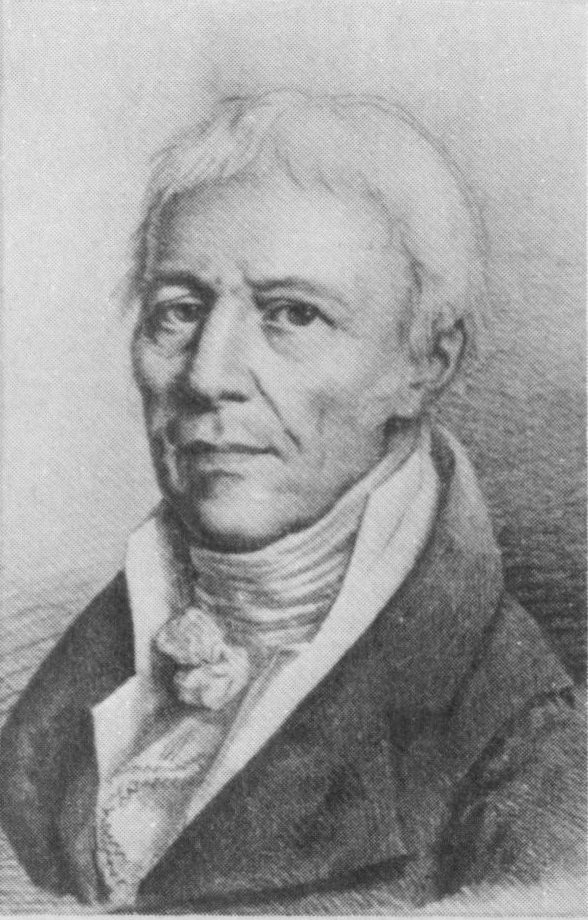
Jean-Baptiste de Lamarck, 1744-1829, a French physician and ex-military man, founded the modern study of animals without backbones and coined the term invertebrates to describe them as a group. When his battle wounds forced him to take up a new career, he studied botany and published a study of French plants. He later turned to invertebrates, and between 1815 and 1822 published the classic Histoire naturelle des animaux sans vertèbres. He applied his vast knowledge of living invertebrates to paleontological work, greatly enhancing the knowledge of fossil invertebrates. Lamarck was also an evolutionary theorist, and he believed that a single characteristic acquired by an animal during its lifetime could be passed on to its descendants by heredity (modern genetic theory was unknown at that time). He saw that evolution must have taken a long time to occur, and he supported the principle which has since become known as uniformitarianism.
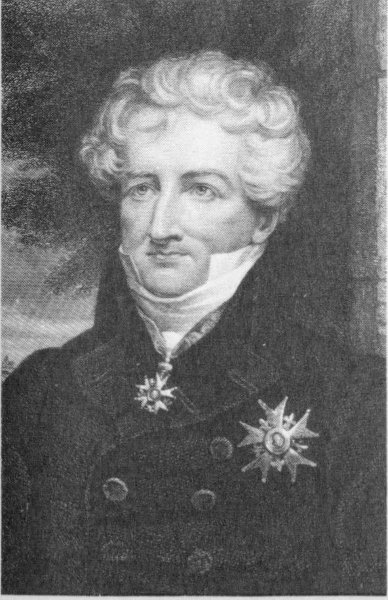
Georges Cuvier, 1769-1832, was a French anatomist and paleontologist who specialized in the study of animals with backbones, the vertebrates. He had a long and brilliant career as a professor, eventually becoming France’s minister of the interior in 1832. His skill as a comparative anatomist enabled him to understand how vertebrate fossils should be reconstructed to form a complete skeleton, and he was one of the first to use the small muscle scars on fossil bones to reconstruct the extinct animal’s musculature. His classic work Récherches sur les Ossemens Fossiles de Quadrupèds was published in 1812. He is known for his theory of a series of natural catastrophes, each supposedly obliterating all extant life, to account for the great variety of ancient fossils. This theory was later supplanted by the theory of continuous evolution supported by Darwin, Lyell, and others.
44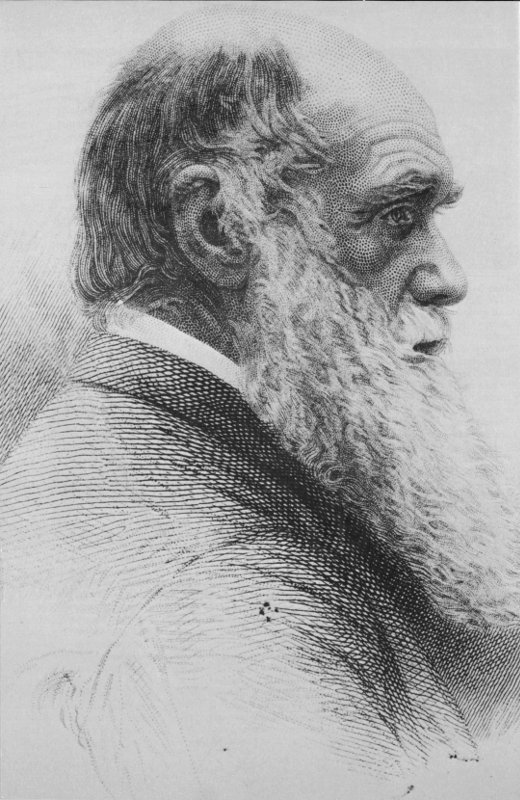
Charles Darwin, 1809-1882, is today a household name that is still invoked in controversy as it was more than a hundred years ago. An extraordinarily patient and insightful biologist, Darwin contributed the idea of natural selection, the “weeding out” of unfit individuals and species, and described it as the guiding principle of the evolution of life on this planet. His book On the Origin of Species by Means of Natural Selection, published in 1859, is the most important landmark in evolutionary studies. This was the culmination of decades of work, leading to conclusions startlingly similar to those of his fellow Englishman, Alfred Wallace. Darwin knew nothing of the genetic principle of biological heredity and variation, which has now assumed equal importance with natural selection in the study of the evolution of life. For paleontologists, Darwin’s work meant they must look for transitional forms of life and not content themselves with Cuvier’s assumptions that past life forms had been static and unchanging. During his travels in South America, Darwin contracted a disease, now known as Chagas’ disease, and suffered intense pain and discomfort the rest of his life. He died of a heart attack on April 19, 1882, and was buried in Westminster Abbey in London a few days later.
45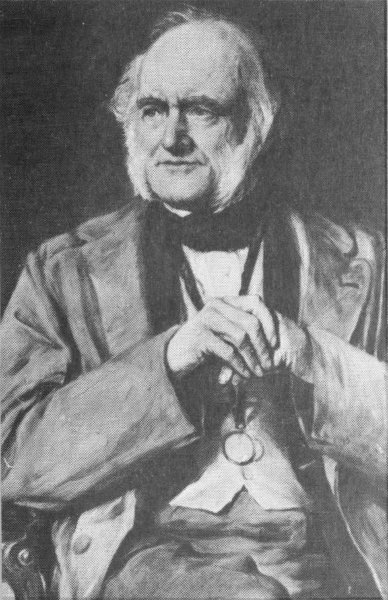
Charles Lyell, 1797-1875, revolutionized the study of geology partly by publicizing the earlier work of James Hutton, who died the year Lyell was born in Scotland, and partly by infusing the science with his own highly disciplined point of view. His greatest contribution was the firm establishment of Hutton’s principle of uniformitarianism, or uniformism, which became the foundation for all modern geological work. Put simply, this is the principle that the processes we see operating to form and shape the Earth today have always operated in the past. Once this is admitted, it becomes clear that past geological time is vast, not short, a truly stunning notion for Lyell’s time but a commonplace fact today. The first volume of his Principles of Geology was published in 1830; in his later works he championed Darwin’s own revolutionary point of view, adding his own powerful arguments in support of the idea of natural selection.
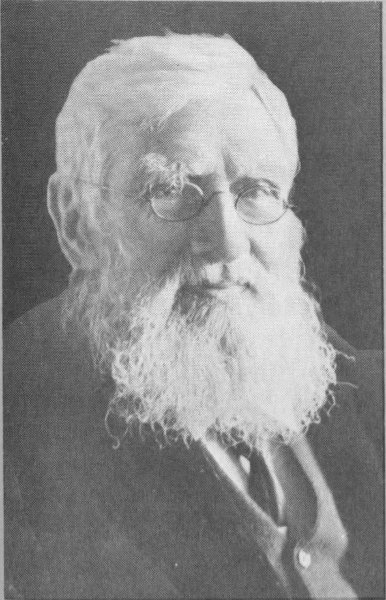
Alfred Wallace, 1823-1913, was the co-originator, with Darwin, of the principle of natural selection, or “survival of the fittest.” The main difference between the two was that Wallace did not believe that natural selection explained things as well as Darwin thought it did, which has been borne out to a large extent by modern studies of genetic variation. Wallace worked in South America, along the Amazon and Rio Negro rivers, and in East Asia. He showed that the animals on either side of a line between Borneo and the Celebes Islands are radically different in their makeup and origin. Now known as “Wallace’s Line,” his work has been vindicated by additional modern studies. Although Wallace did not become as well known as Darwin, his brilliant, independent studies lent a great deal of weight to the Darwinian view of evolution.
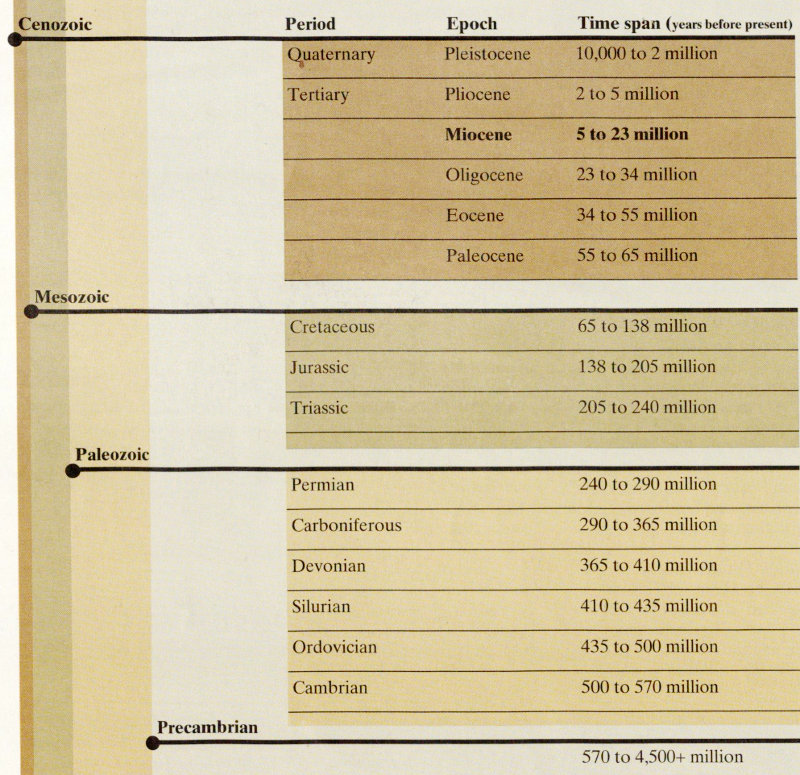
The largest divisions of geologic time are eras, shown above in chronological order from the oldest on the bottom to the most recent on top. The scale at left shows the relative duration of each era. As the chart shows, geologists further divide time into periods and, in the Cenozoic Era, into epochs. The fossilization of animals in the Agate Springs area of Nebraska took place in the Miocene Epoch. Adjustments to this time chart are made as new data becomes available, so it should not be thought of as an unchanging reference. This diagram is adapted from one in The Emergence of Man series published by Time-Life Books.
| Geologic Time Chart | |||
|---|---|---|---|
| Period | Epoch | Time span (years before present) | |
| Cenozoic | Quaternary | Pleistocene | 10,000 to 2 million |
| Tertiary | Pliocene | 2 to 5 million | |
| Miocene | 5 to 23 million | ||
| Oligocene | 23 to 34 million | ||
| Eocene | 34 to 55 million | ||
| Paleocene | 55 to 65 million | ||
| Mesozoic | Cretaceous | 65 to 138 million | |
| Jurassic | 138 to 205 million | ||
| Triassic | 205 to 240 million | ||
| Paleozoic | Permian | 240 to 290 million | |
| Carboniferous | 290 to 365 million | ||
| Devonian | 365 to 410 million | ||
| Silurian | 410 to 435 million | ||
| Ordovician | 435 to 500 million | ||
| Cambrian | 500 to 570 million | ||
| Precambrian | 570 to 4,500+ million | ||
Although the whole story of Agate Fossil Beds dates from the formation of the Earth four and one half billion years ago, only the last 600 million years is known in detail. It was about 600 million years ago that many plants and animals began to have hard parts—parts likely to be preserved as fossils. The few fossils contained in older rocks are often folded, twisted, squeezed, and distorted so that their original character is all but erased. That isn’t always the case, of course. Some of these old rocks, the Belt Series in Montana, look as though they were deposited only a few million years ago; they contain traces of algal colonies indicative of the generally simple life forms on the primitive Earth. The old rocks, deposited during the first four billion years of Earth’s history, record the Precambrian Eons, spanning eight-ninths of geologic time.
The evolutionary development of skeletal remains has aided in the study of geologic history. The last 600 million years have been divided into units for ease of discussion and comparison. The three largest divisions are the eras—Paleozoic (ancient life), Mesozoic (middle life), and Cenozoic (recent life). We are viewing all this from our vantage point at (what is now) the most recent episode of the Cenozoic.
To begin at the known beginning, we only need go back to the start of the Paleozoic Era some 600 million years ago. No Precambrian, Paleozoic, or Mesozoic rocks can be seen around Agate, but we know from rocks found in comparable areas about what to expect under the surface at Agate: thousands of meters of sedimentary rocks, most of them laid down in an ocean. During the Paleozoic and most of the Mesozoic eras, up until about 70 million years ago, the west-central United States was covered by seas. The area now occupied by the Rocky Mountains was then a long north-south trough in which thick sediments collected. To the east, the present Great Plains area was the floor of a shallower sea. Sediments collected in the trough and on the sea bottom. Gradually, over a period of 530 million years, the sediments accumulated to a thickness of over 2,100 meters (6,900 feet). A dynamic “give-and-take” 48 process, this sedimentation was the result of periods when the sea rose and fell several times.
If the Paleozoic sounds a little dull, it’s because we haven’t told the whole story. During the Paleozoic Era, all the major groups of organisms evolved. The seas swarmed with trilobites and shellfish of all kinds, some weird and fantastic and some very like those alive today. With them coexisted fish and sea-lilies, seaweeds and giant swimming “scorpions.” For the first time, plants and then animals came out of the sea to live on the land. These events and creatures are preserved in Paleozoic rocks. The Mesozoic Era saw the development of mammals from reptiles, the rule of giant dinosaurs, and the beginnings of flight. Strange reptiles evolved and returned to the sea, or glided through the air on motionless wings. The Sundance Formation, deposited in the northern Rocky Mountains about the middle of the Mesozoic Era, is noted for the masses of bullet-shaped squid shells found in it. Water, land, and air were full of life.
In the Middle Mesozoic, the trough drained and much of it became an area of swamp and tropical forest extending from Montana to southern Utah. This was the domain of our largest dinosaurs, giant reptiles whose bones were preserved in impressive numbers. Como Bluff and Bone Cabin, Wyoming; Morrison, Colorado; and Dinosaur National Monument and Cleveland, Utah, are the sites of quarries where many fine specimens of Apatosaurus, Diplodocus, Stegosaurus, and Allosaurus have been collected. These caches of bones have made our large museums showplaces known throughout the world.
During the last 65 million years of the Mesozoic, the trough fluctuated up and down. During much of that time a broad, shallow sea covered central North America from the Gulf of Mexico to the Arctic Ocean. The sea was filled with fish like the giant Portheus (3.5 meters/11.5 feet long), with squid-like animals floating about in elaborate chambered shells, and with reptiles which had gone back to the water. Where there was a broad coastal plain, it swarmed with dinosaurs, the ones that make Lance Creek, Wyoming and Hell Creek, Montana famous collecting grounds for museum field parties. Yet at the end of the era the trough was a seaway again, and in the Agate area a final blanket of black mud, the Pierre 49 Shale, was deposited in the sea.
At the end of the Mesozoic Era a profound change came over the land. The trough, with hundreds of meters of sediments accumulated on its bottom, was drained and folded by pressures built up in the Earth’s crust. To the south, the Colorado Plateau rose slowly and smoothly; to the north folding and faulting built complex mountain ranges. This uplift is called the Laramide Revolution because of the magnitude of the change it made on the face of the continent.
At the beginning of the Cenozoic Era, about 65 million years ago, the Rockies and the Great Plains were slowly rising. Rains fell and rivers carried the water, wearing away the old sediments. Some sediments were carried west into the Pacific Ocean, or deposited on the land and covered over by new sediments. Some sediments remained within the Rockies, settling into basins during the early Cenozoic. Other sediments were carried east by the rivers, beyond the Great Plains and into the Mississippi Embayment. Mountain building and erosion tended to cancel out one another in the Rockies, preventing the mountains from reaching great heights. The mountain bases were perhaps no more than 300 meters (1,000 feet) above sea level, and the crests perhaps 600 meters (2,000 feet) above that.
Before long, the basins within the Rockies filled with sediments. The basins overflowed, and at last sediments began to cover the Great Plains. This was near the end of the Eocene Epoch, about 35 million years ago. Subtropical rivers, flowing sluggishly, rolled out over their banks and left their loads of silt and clay on the featureless plain.
The oldest part of the blanket of sediments, the White River Beds, extended from Saskatchewan to Texas. Nearly 200 meters (650 feet) of muds, clays, silts, and river gravels were laid down during the 11 million years of the Late Eocene and Oligocene Epochs. Magnificent exposures of these beds can be seen at Scotts Bluff National Monument in the valley of the North Platte, in Toadstool Park north of Crawford, Nebraska, and particularly in the Big Badlands of southwestern South Dakota.
The kind of floodplain deposition characteristic of the Oligocene on the Great Plains ended about the beginning of the next epoch, the Miocene. In Nebraska 50 the process continued, but eventually erosion began wearing away the accumulated sediments. The land to the west was uplifted a little, and the streams flowed off the high ground fast enough to cut down into what they had just deposited. On this eroded surface, the layers of tan silts, fine sands, and clays known as the Gering Formation were deposited.
On top of the Gering Formation, in the Late Oligocene, is the Monroe Creek Formation, the oldest formation actually exposed in the Agate area. This formation is named for exposures in Monroe Creek Canyon north of Harrison, Nebraska, and may be up to 75 meters (245 feet) thick. You can see a little of the Monroe Creek Formation’s pinkish silts and volcanic glass shards exposed in the valley of the Niobrara River. Where it is more exposed by erosion than at Agate, the Monroe Creek Formation forms magnificent cliffs along the Pine Ridge and similar areas of high ground. The best local examples are at Fort Robinson State Park between Harrison and Crawford, Nebraska. A close look can be obtained in Smiley Canyon just west of the fort, where old U.S. Highway 20 is maintained as a scenic drive.
After the Monroe Creek interval, near the end of the Oligocene, deposition of the famous Agate Fossil Beds began. Geologists have named this sequence of grayish silts and sands the Harrison Formation for its occurrence near Harrison, Nebraska. A short interval of erosion separates it in some areas from the Monroe Creek Formation below, and its coarser sands indicate increasing uplift of lands to the west. Wind played a smaller role in deposition than in Monroe Creek times, though that is certainly not true at the Stenomylus quarry. The Harrison Formation was the last of the truly widespread deposits seen in the Miocene of the Great Plains. Many rivers flowing eastward from the Rockies contributed sands to Wyoming, South Dakota, and Nebraska.
Generally the Harrison Formation and the overlying Marsland Formation are only moderately fossiliferous, but along the Niobrara River here at Agate, Nebraska, the accumulation of rhinoceros and camel skeletons is one of the wonders of the fossil world. Here, thousands of animals perished in two droughts which coincided with conditions perfect for preservation. About two kilometers (1.2 miles) east 51 of the Monument headquarters the dried-out, mummified bodies of perhaps a hundred or more little camels, Stenomylus hitchcocki, were buried under windblown sand during the first drought.
Shortly after the camels were buried there was a brief period of erosion and then the Marsland Formation began to be deposited. Named for a little village east of Agate, the Marsland Formation consists of basal river channel deposits followed by about 45 meters (150 feet) of wind-blown tan-and-gray sands. It is in one of these river channel deposits that the Agate rhinoceros quarries are located.
The second drought occurred early in Marsland times and literally hundreds of the little rhino, Menoceras, were preserved when their carcasses were broken up by a reborn river and buried like a mat of jackstraws in a river lake.
After Marsland times there was more erosion, in some places by rushing streams that cut down 91 meters (300 feet) through soft sediments, to the top of the Monroe Creek Formation. In these channels the Runningwater Formation was deposited because it filled in the stream valleys and wound around the high spots. This channel deposit is not found everywhere, but it does have an equivalent in southwestern South Dakota. Other deposits of similar age are found in many parts of the Great Plains, and they contain fossil animals like those found in the Runningwater Formation.
The turbulent streams which deposited the Runningwater Formation were flowing off newly uplifted land to the west. This was the beginning of the most recent major uplift of the Rocky Mountains, and it signalled a great change in the pattern of deposition on the Great Plains. No longer would broad blankets of sediments be deposited by sluggish streams originating in the low, broad warp of the Rockies.
This latest uplift is called the Rocky Mountain Revolution. It brought on a period of alternating cycles of deep channel cutting and stream deposition. Floodplain deposits were restricted to narrow ribbons in river-cut valleys. Even more important than the changes in deposition was the effect of this uplift on the climate. As the Rockies began to rise to their present height, the climate became increasingly arid and the tree-dotted savanna of the old Great Plains gave way to grasslands.
Several kilometers south of Agate, the Sheep Creek Formation was laid down during the Middle and Late Miocene. The appearance of the grazing horse Merychippus in these channel and floodplain deposits marked the establishment of the grasslands as the newly dominant ecosystem of the Great Plains. At that time the “modern” fauna began to replace the old, and new patterns of life were established.
Again rejuvenation of the stream system, probably reflecting further uplift in the west, started another erosional interval that began to wash away the beds just deposited. When deposition followed in the Late Miocene, a new series of channel and floodplain deposits, the Lower Snake Creek Beds, was laid down. On them was deposited the Upper Snake Creek Beds, and together they span most of the Late Miocene and the Early and Middle Pliocene epochs. Harold Cook collaborated with W. D. Matthew of the American Museum of Natural History, publishing important papers on the numerous finds from these fossiliferous deposits. Animals new to science are still being discovered in the Snake Creek Beds.
After Snake Creek times, the area immediately around Agate was left out of the mainstream of events on the Great Plains. The continuing uplifts of the Rocky Mountains were no longer recorded here in cycles of downcutting and channel deposition. If the cycles continued here, all traces have now been washed away—an unlikely possibility. The view from the high plains above the valley of the Niobrara River reveals only the rolling surface of the pre-Runningwater deposits.
A more complete record is found in the river terraces of major streams, the North Platte to the south and the White and Cheyenne Rivers to the north. These terraces tell the story of continuing uplifts. To the south, east, and northeast of the Platte the record is also written in fossil bones, but these are outside the scope of our story.
Northwestern Nebraska, northeastern Colorado, southeastern Wyoming, and southwestern South Dakota today remain a promised land for paleontologists studying mammal life in North America during the middle and later Cenozoic Era. The fossil deposits in the Agate area are surpassed in importance only by the Late Eocene and Oligocene deposits of the Big Badlands and Pine Ridge in South Dakota.
During the Age of Mammals (the Tertiary Period), three major environments dominated western Nebraska. The first of these occurred during the Paleocene, Eocene, and Oligocene epochs. This was a forest system where trees were the major component of the flora. Meadows were found only in scattered areas and can be considered a minor element. There is no geologic or paleontologic record of the Paleocene and Eocene in the Agate area, but when our present knowledge of the early Tertiary Rocky Mountain floras is projected eastward a bit, a predominantly forested landscape is indicated.
It is in some ways ironic that while the Oligocene land-laid sediments of southwestern South Dakota, western Nebraska, southeastern Wyoming, and northeastern Colorado contain one of the best vertebrate fossil records in the world, the plant record is almost non-existent. Unfortunately the groundwater chemistry that was so right for the preservation of bones was hostile to the preservation of plants. Hackberries (Celtis) and walnuts (Juglans) are the only recorded plant species from the Oligocene in this very large area. Because these are such widespread and climatically tolerant types, they tell us almost nothing about the environment. Indications of the flora at Agate may be obtained, however, from the extraordinary Late Eocene flora found at Florissant, Colorado, south of Denver. Although this deposit does contain some upland species, it generally indicates a warm temperate forest including such things as horsetail rushes, ferns, cattails, grasses and sedges, poplar, willow, birch, oak, elm, serviceberry, sycamore, maple, sumac, and—of course—hackberries and walnuts.
During the Early Miocene, slightly changed climatic conditions brought about by minor uplifts in the Rocky Mountain area transformed the immediate area of western Nebraska into a savanna of mixed trees and grasslands. This second system probably reached its climax just about the time the Harrison Formation was being laid down during the Early Miocene. This was a savanna with scattered clumps of trees, gallery forests, and grasslands. The modern world’s richest and most diverse fauna of hoofed mammals can be found on the savannas of east Africa. On the savannas, grazing and browsing (grass eating and leaf eating) adaptations of the larger plant eaters are represented.

35 million years ago, life along the Niobrara River near Agate would have appeared something like this. Two oreodons (1) have startled an alligator (2) and two hippopotamus-like Aepinacodons (3) along the river bank. Climbing a tree is an opossum (4), one of the oldest forms of life in the world today. Note the many familiar trees and plants, particularly the cottonwood, willow, beech, dogwood, and cattail.
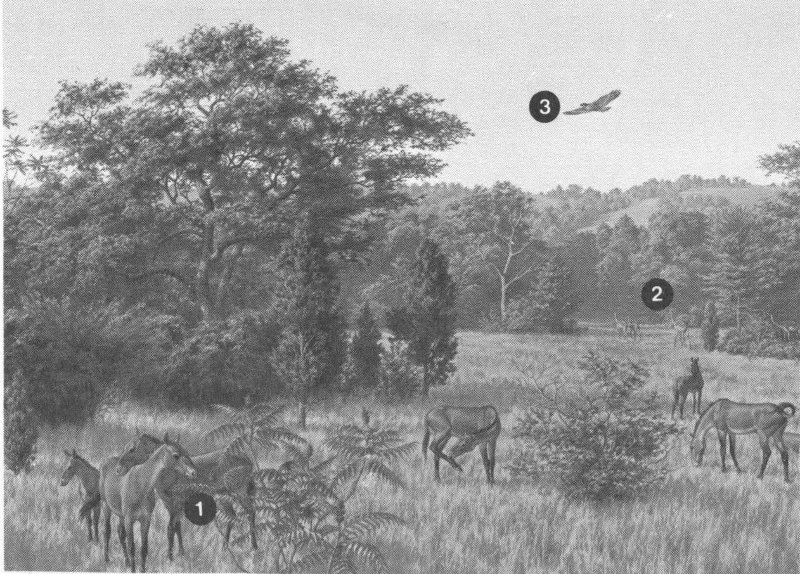
25 million years ago, a savanna dominates the Agate landscape. Copses of oak and pine are interspersed with open grassland. In the foreground are several Parahippus (1), an ancestor of today’s horse, while Oxydactylus camelids (2) move away into the distance and, overhead, a hawk (3) searches for rodents.
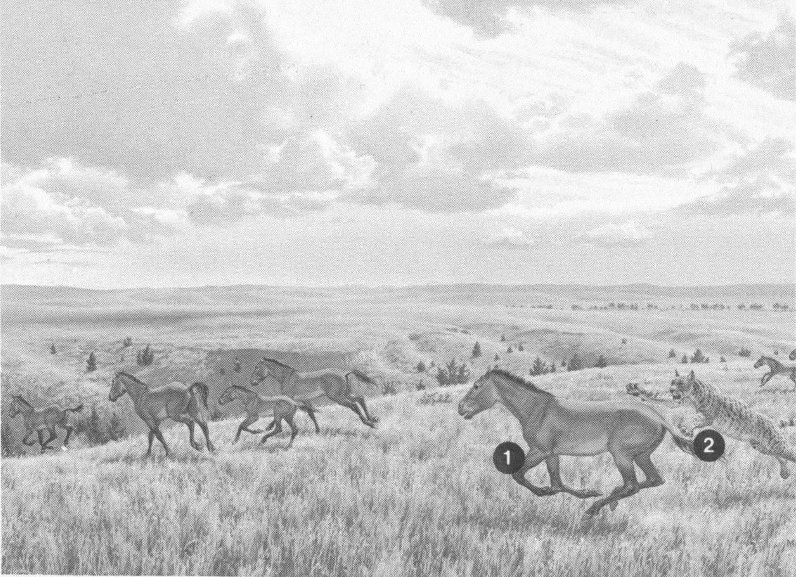
15 million years ago, the Agate landscape has changed to an open prairie. A small herd of Merychippus horses (1) races toward the arroyo in the distance, narrowly escaping ambush by a large, leopard-like cat known as Pseudaelurus (2). A few cottonwoods, elms, sycamores, and willows grow along the river, but cedars predominate in the arroyo in the middle ground, where they are protected from winds that sweep across the plains. Though the animals have changed, the landscape is essentially like this today.
In western Nebraska the savanna environment lasted for only a very short time, in a geologic sense, before it gave way to a wave of advancing grasslands, the third phase of Tertiary environment in the area. Tallgrass prairie such as that still found 325 kilometers (200 miles) east of Agate a century ago must have been first among the grassland types. Trees, when present at all, were restricted to the borders of streams. Then as the climate became even more arid the prairie or tall grass retreated eastward, while the forest moved before it even farther to the east and south, and the modern shortgrass of the plains took its place. Today Agate lies in one of the valleys whose rivers are slowly dissecting the High Plains.
The modern plains are dominated by short, curly, sodforming buffalo grass, a plant well adapted to the area’s light rainfall, periodic droughts, low humidity, rapid evaporation, and high winds. The dominant vertebrate animals are burrowers and grazers, and dogs are the primary carnivores. Hoofed animals such as the pronghorn, the ultimate in the running and bounding adaptation; jumpers and hoppers, such as jackrabbits and jumping mice and rats; and burrowing mound builders, such as the prairie dog (a large ground squirrel), the pocket gopher, and harvester ants typify the major occupations of plains animals.
The environmental type seen on the Great Plains of North America is elsewhere best developed in the Pampas of Argentina, the Puztas of Hungary, the Veld of Africa, and the Steppes of Russia. In the climatic classification of the climatologist and geographer, the term steppe climate is applied to all these areas, the Great Plains included.
If the savanna is the halfway station between forests and grasslands, then the fossil fauna of the Early Miocene at Agate was a fauna in the beginning of a serious transition. In the vicinity of Agate, the fauna from the Late Oligocene was dominated by mammals with low-crowned teeth. The crown is that part of the tooth which is above the roots and exposed beyond the gums. Among the herbivores, the 62 browsers can live a long life with low-crowned teeth. But when any appreciable amount of grass, particularly the short, tough grass of the plains and the abrasive dirt and sand that accompanies it, becomes part of an herbivore’s diet, there is a great increase in the rate of tooth wear. Teeth which have evolved for browsing quickly wear down to the gums and the individual dies of starvation.
Accompanying the development of extensive grasslands came the evolution of the high-crowned tooth. This process begins simply with the growth of a taller crown that erupts completely from the gum right after the milk or deciduous teeth fall out. Another step is the development of a longer or higher crown most of which is held in the jaw and then slowly pushed out as the chewing surface is worn down. This is the “mechanical pencil” effect in that the “lead” may be pushed out as needed. Teeth of this type are perhaps best seen in the later horses. From their appearance in the Late Paleocene until the end of the Early Miocene, all horses had low-crowned teeth. With these they could chew the soft leaves and twigs of trees and shrubs, first in the forests and later in the groves and clumps on the developing savanna. By Early Miocene (i.e., Harrison) times, there was only a slight increase in crown height in Parahippus, but it had evolved an increasingly complicated crown pattern which served to lengthen the time it took for the tooth surface to wear down flat. With the greater aridity of the changing climate, the teeth of Parahippus became higher and higher crowned, as the individuals with the best teeth lived longest and had greater opportunity to produce offspring than those with lower-crowned teeth. In some species, the tooth material called cement, which ordinarily covers the roots of the teeth, began also to cover the enamel of the crown and give additional wearing strength to the teeth. Soon after the beginning of the Middle Miocene, two species had developed cement-covered teeth whose crowns were high enough to warrant placing them into two new genera of horses, Merychippus and Protohippus. These forms, first recognized in the Lower Sheep Creek Beds in the Agate area, were the first horses to use the mechanical-pencil effect, having cheek teeth that continued to rise out of the jaw as the tooth was worn down. Merychippus later 63 gave rise to a line of three-toed horses, which lived on into the Pliocene; Protohippus gave rise to a line which ultimately led to Equus, the modern horse.
The ultimate in high-crowned teeth occurs when roots do not ever form at the base of the tooth; additional crown material is constantly added at the bottom of the tooth as it is pushed out of the gum. This type of growth resembles the foundry process of extrusion, where metal or plastic is pushed through a mold to produce a continuous strand. This extreme development is seen in the incisors or gnawing teeth of beavers, gophers, and other Late Oligocene rodents, and in the grinding teeth of only a few forms. The cheek teeth (the grinders) of modern pronghorns (artiodactyls), gophers (rodents), and rabbits (lagomorphs) are typical of this kind of development today. During the Middle Oligocene, only the strange little fox terrier-sized, flat-headed oreodon Leptauchenia, the tiny “deer” Hypisodus, and the rabbit Palaeolagus had mechanical pencil-type teeth. Some of the rhinos then had fairly tall crowns, but these don’t really qualify as high-crowned teeth. It was not until later on, when the grasslands took over completely, that high-crowned teeth really came into their own.
There was no dramatic change in the fauna at the beginning of the Miocene, and many Oligocene genera carried over into the new epoch. Most of the Eocene hold-overs, primitive animals that had survived in the extensive forests, became extinct when the forests began to retreat; but for the most part the record continued undisturbed. This is to be expected where the deposition of sediments continues without interruption. (Remember that the epochs, periods, and eras were originally based on breaks in the European sedimentary record reflecting local events which would not necessarily show up in North America’s sediments.)
By the time the Harrison Formation was deposited, the development of the halfway world of the savanna was beginning to affect the fauna. Although the Oligocene and the very earliest Miocene mammal faunas were highly varied and rich in types of animals, much of this was due to the continued presence of primitive and archaic forms, and to the explosive development of rhinos and oreodons. With the savanna becoming the dominant landscape, the shift to grazing and away from browsing became evident. Or, at least, the presence of animals that both browsed and grazed was indicative of changing times. As was mentioned earlier, grazing and burrowing are characteristics of plains herbivores. In such a transitional period we would expect to find an increase in burrowers and grazers as grasslands became more common.
Animal species respond to environmental changes in a variety of ways. Simply put, some species die off, some adapt physically, and some move to a different habitat. On the next few pages are examples showing how three species responded to long-term environmental changes in the area around Agate Fossil Beds. The Stenomylus line died off; Miohippus’ evolutionary line remained a grazing animal but changed physically over the years, eventually becoming the modern horse; and the Palaeocastor line moved from land to water, gradually evolving into the beaver.
Each of these three animals is portrayed here with partial skeleton, musculature, and outer skin to help you see its general composition and to emphasize certain physical features that developed in the species over time. Paleontologists, of course, work this way. From fragments and bones they reconstruct full skeletons, and from surmises about muscular structure, often based on present-day animals, they project the appearance of the animal. The artist, in this case Jay Matternes, then brings together these bits of evidence to give us a picture of life long ago.
Stenomylus
A small, gazelle-like camel similar to the present-day gerenuk of Africa. Stenomylus is the second most common animal found in the fossil beds at Agate. Stenomylus had hard hooves like modern antelopes and deer, unlike modern camels which have flesh-padded feet adapted to desert terrain. The three-hued coat is inferred from the coat of the modern gazelle, a similar form in adaptation. Stenomylus’ evolutionary line eventually died out in North America at the end of the Pleistocene. No one knows why both camels and horses died out on this continent.
65The distance between grid lines represents five centimeters.
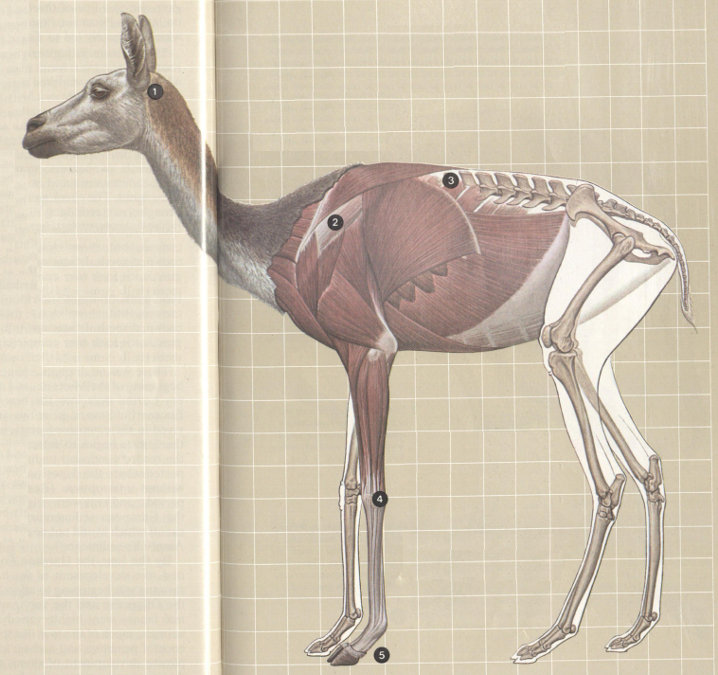
1 The ears moved in a parallel fashion, not independently; the parallel movement is inferred from modern llamoids, to which Stenomylus is related.
2 Stenomylus’ musculature was adapted for high-speed running, similar to the present-day pronghorn.
3 The back structure suggests that Stenomylus would have made short, choppy leaps, not the graceful, arcing leaps of a modern impala.
4 Limbs were long in proportion to the body, allowing the animal to run with great speed.
5 Stenomylus had a hard, chitinous hoof, an adaptation for greater running speed, and for sure footing on rough terrain.
66Miohippus
Over the last 60 million years the horses have evolved from small, terrier-sized animals to the diversity of size we know today, from the huge Clydesdales to the diminutive Shetland ponies. The three-toed early horse known as Miohippus was about the size of a sheep. The descendants of Miohippus apparently went in two directions in their evolution: One group continued to be forest-grazing, three-toed horses that eventually reached the size of modern horses but died out later. The other group, through such intermediate forms as Parahippus, became grassland forms that led eventually to the modern one-toed horses. Horses became extinct in North America at the end of the Pleistocene, but no one knows why. They continued to evolve on other continents and were re-introduced in historic times.
67The distance between grid lines represents five centimeters.
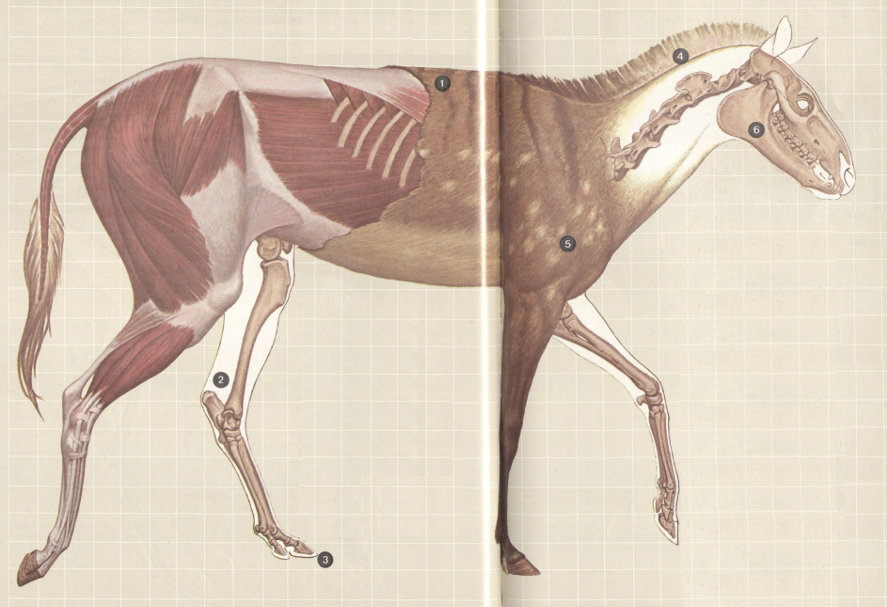
1 The back was straighter and stiffer than in earlier horses, partly because of the increasing size of the animals and partly to allow sustained open-plains running.
2 Limbs were long in proportion to the body, an evolutionary trend in the horses for speed in open-plains running, rather than darting about in forests.
3 Most of the weight of the animal was on the middle toe, which has become a single toe in modern horses. This is an adaptation for endurance and stability in open grasslands.
4 The upright mane is a primitive horse characteristic; wild horses today have reverted to this trait.
5 The coat is shown as striped, a probable holdover from earlier horses that dwelled in forests, where a striped coat would provide camouflage.
6 A large, deep mandible supported teeth adapted to grazing and the grinding of grasses and other wild plants. The teeth were deep-rooted and continuously erupted as the surface was worn down by the grit and dirt that came with the large quantities of plant food consumed daily.
68Palaeocastor
Palaeocastor was an ancient beaver whose mode of life was like that of a modern prairie dog—land-oriented instead of water-oriented. Palaeocastor was small, about 12 centimeters (5 inches) high, and about 30 centimeters (12 inches) long. Its fossilized spiral burrows, called Daemonelix, survive to tell us what its habitation was like, a feature unique to Palaeocastor among all the fossil beavers. The Daemonelix shown here dwarfs a member of Olaf A. Peterson’s field crew from the Carnegie Museum. The bones of a Palaeocastor and one of its predators were found at the bottom of one such burrow, helping to prove that Palaeocastor was responsible for making these corkscrew holes in the ground.
The distance between grid lines represents five centimeters.
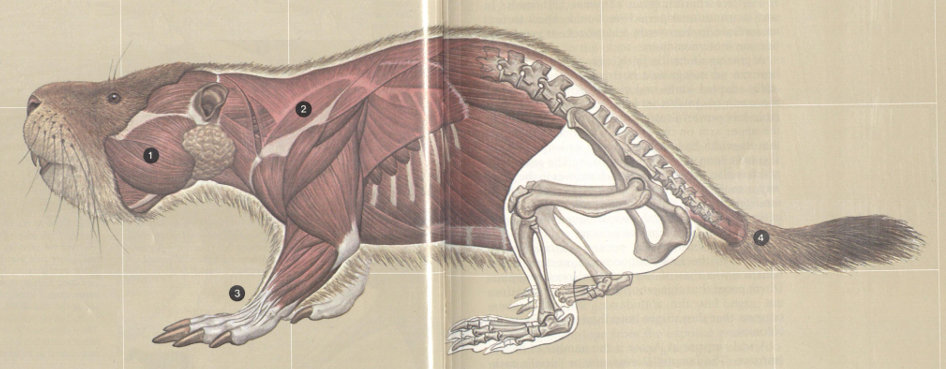
1 The powerful jaw and musculature allowed for grazing on grasses and other plants, as well as masticating. The teeth were deep-rooted and would continue to erupt as the surface was worn down.
2 The complex musculature supported the use of the forelimbs in burrowing. Palaeocastor had a collarbone or clavicle, like us, for greater agility in using the forelimbs.
3 The forelimbs were adapted to burrowing in the ground.
4 The tail is like that of a modern burrowing rodent, such as a muskrat, whereas the modern beaver has a different, very specialized tail.
69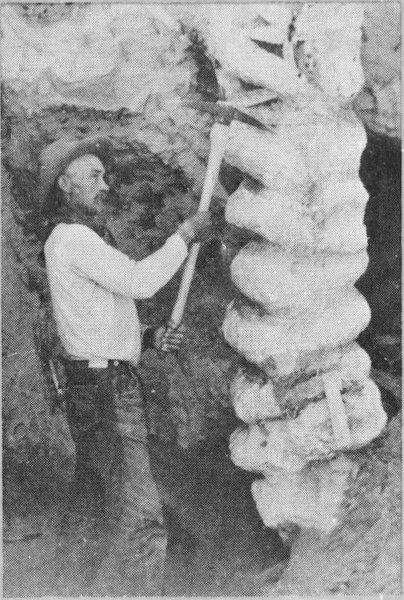
A grazing animal is fairly easy to recognize, but how can we recognize a burrower? Some have radically adapted limbs and claws. Obvious cases are the common garden mole and the armadillo. The mole has powerful attachments for the muscles of the upper arm on the humerus, a bone so flattened that its width has come to match its length. Moles also have long, broad digging claws. The armadillo, which is also a digger but not a burrower in the same way a mole or a gopher is, has large curved claws for digging. Moles did start to become quite common in the Late Oligocene, so we can assume that a good burrowing environment was present.
Another group which became extraordinarily common in the Late Oligocene of western North America was that of the ancestral pocket gopher. Direct proof that this group actually burrowed does not exist, but the abundance of fossil gophers suggests that they might have lived underground in colonies.
A real surprise at Agate is the number of beaver burrows. The famous Daemonelix or “devil’s corkscrew” attests to the dense population of Palaeocastor. By that relatively advanced stage of beaver evolution, the animals might be expected to behave like the modern-day muskrat, perhaps digging dens along stream borders and spending some of their time in the water. The presence of skeletons in the spiral burrows, however, indicates that Palaeocastor was primarily a burrower, one which perhaps lived very much like our present-day prairie dog. Despite that, there is no apparent structural modification to indicate burrowing abilities.
Changing environmental conditions were pushing Palaeocastor toward extinction in the Early Miocene. The disappearance of that ancient beaver, while not unusual, presents a problem for the careless observer who might assume that ancient animals behaved like their modern counterparts. The burrowing beavers 71 of Miocene Agate certainly have no modern counterparts.
While we can delineate in a general way the prehistoric life of Agate, we can’t describe the past in any detail. Plants most directly reflect the effects of climate—and plant fossils are absent at Agate. As the base of the food chain, plants carry the influences of climate on to the plant-eating animals. From the numerous animal fossils found at Agate we have learned most of what is known about the environment of that time. Sediments tell a good part of the story, and floras from other localities help, but much of Agate’s ancient ecology must be inferred from the bones.
Today, standing on the porch of the visitor center or walking along the path to University and Carnegie Hills, visitors find themselves in the midst of the shortgrass prairie. Five distinctive plant communities share this prairie, coexisting in a dynamic relationship which depends upon local climate variations.
Even to the untrained eye, it is evident that the basic short-grass pattern has been modified by the shape of the land and by the Niobrara River. In the stream valley, along the tributaries, and on shaded north-facing slopes, the shortgrass community is mixed with taller grasses. If a dry cycle began, the short grasses would take over the whole area by migrating downslope from the exposed prairies. Of interest is the fact that over-grazing by either domesticated or wild animals will have the same effect as a dry period in that taller grasses will be replaced by short ones.
Let’s examine the five communities present today so we can appreciate the complexity of relationships between living things and the earth upon which they depend.
First, we can begin in the Niobrara River itself. The river’s water-dwelling plant inhabitants include algae, which grow underwater.
Between the river and the dry ground is a second community—the marsh—which is often more wet than dry. The marsh has its own characteristic plant association. Most familiar are the cattails, mints, and willows, but just as important ecologically are arrowleaf, rush sedge, marshweed and blue verbena. These are moisture-loving plants that thrive on being thoroughly soaked during the wet part of the year.
Beyond the marsh on the valley floor is a third community. Here the water table (the top of the saturated soil and rock zone) is close enough to land surface that the plants can easily send their roots down into the saturated zone. Here, in what the plant ecologists call the “sub-irrigated floor plain” we find a mid-grass community. Eighty-five percent of the vegetation is slender wheatgrass. Its wheat-like heads may, under favorable conditions, grow to a height of one meter (three feet). At Agate it is seldom over knee high. Kentucky bluegrass takes care of another 10 percent of the plant population. Imported from Europe as a pasture grass in the 1600’s, it spread so rapidly that it often beat the settlers onto new land as they moved westward. The remaining five percent includes imported redtop and such native grasses as switchgrass, foxtail barley, little bluestem, prairie cordgrass, and inland saltgrass. Wildflowers such as Flodmon thistle, yarrow, heath aster, salsify, and blue-eyed grass complete the community.
Moving farther away from the stream, we rise up onto terraces within the valley. These terraces represent levels where the stream paused in its downcutting and cut sideways for awhile. At a drier level, on deep, well-drained sandy soils, they support the fourth or mixed-grass community.
No exotics have yet appeared in this plant community. The grasses include prairie sandreed, sand bluestem, blue grama, needle-and-thread grass, and Indian ricegrass. Wildflowers include the prominent phlox, penstemon, and lupine. Unwelcome (to man and his grazing animals) is Astragalus, the selenium-concentrating plant better known as loco weed. The brittle prickly pear and spiderwort cactus are found here too.
At higher levels in the terrace community, slightly steeper slopes and shallower soils cause some change in this mixed-grass assemblage. Here the dominant grasses are little bluestem, threadleaf sedge, needle-and-thread grass, and blue grama. Lupine disappears, and common pricklypear becomes the only cactus. In this community is found the yucca, its flowers a beautiful soft yellow in season and its spiny leaves painful at any time of the year. Avoid this plant; yucca spines break off under the skin and soon cause irritating festers. The yucca moth, often seen 73 flying around the yucca seed pods, lays eggs in the plant’s lemon-sized fruits. Inside the fruit are long rows of flattened, wedge-shaped seeds. When the yucca moth eggs hatch into caterpillars, they eat their way through the seeds, killing them. On the other hand it is the yucca moth with its long tongue that is solely responsible for pollinating the yucca flower! If you find a yucca fruit in early summer, you can (elsewhere than in the park) slice through it and see the caterpillars at work.
On the high bluffs and overgrazed terraces is the fifth community, the short grass. This community too can be divided into two slightly different parts. The bluffs support blue grama grass, needle-and-thread grass, and Sandberg blue grass. Flowers and shrubs include Eriogonum, brittle pricklypear cactus, pepperweed, penstemon, broom snakeweed, fringed sagewort, and yucca. The other part of this community, the overgrazed terraces, have threadleaf sedge, needle-and-thread grass, and blue grama. Except for the familiar penstemon, all the flowers are restricted to this community. Gronwell, menzania, and bee plant are indicators of overgrazing.
Certain cyclical variations are characteristic of these plant communities. First, the shortgrass and mixed-grass areas ebb and flow with changing moisture conditions from year to year. Second, grass populations change with the seasons. Cool-season grasses (foxtail barley, Indian rice grass, Kentucky bluegrass, needle-and-thread grass, Sandberg blue grass, and slender wheatgrass) flourish during spring and fall. During the warm summer the blue grama, inland saltgrass, little bluestem, prairie cordgrass, prairie sandreed, and switchgrass predominate. This natural adaptation to seasonal conditions uses the greatest potential of the growing season and at the same time provides species that will flourish in both wet and dry cycles.
After reading this last section, you might look back at the section on Early Miocene ecology. Comparison reveals that a great deal of information can be obtained by examining living plants. In contrast, the lack of fossil flora from the Early Miocene at Agate has resulted in a scarcity of ecological information from that early epoch. Scientists begin their reasoning by such comparisons; you can begin your own exploration of the past in the same way.
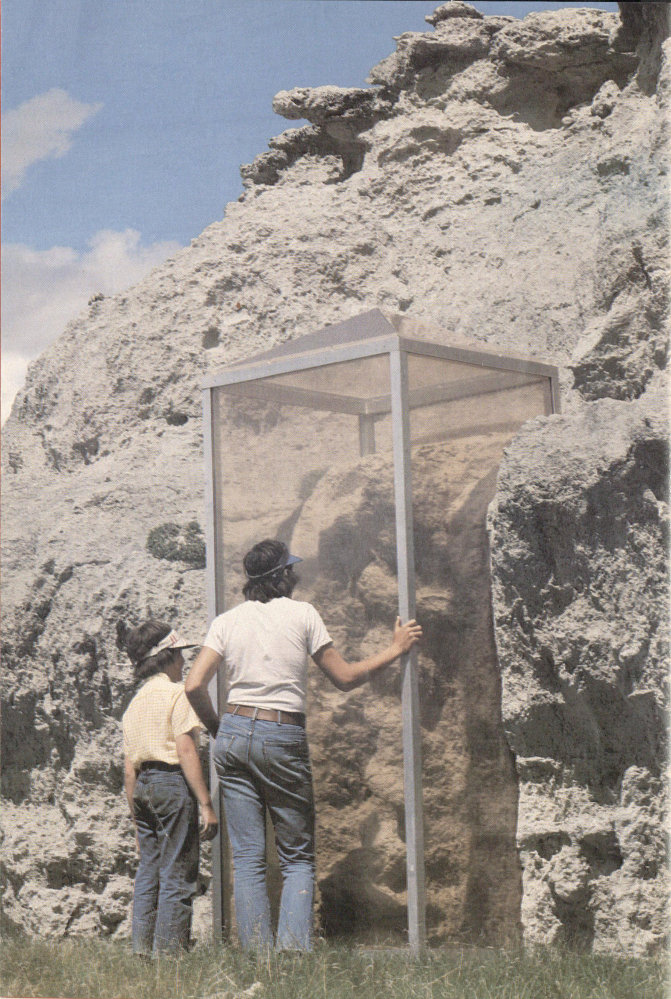
Ask a ranger for directions to the protected example of a Devil’s Corkscrew, the fossilized burrow of a small, beaver-like animal called Palaeocastor. See pages 68-69 for more information about this interesting animal.
Northwestern Nebraska 69 kilometers (43 miles) north of Scottsbluff along the Niobrara River.
1,116 hectares (2,762 acres).
Temperatures range from winter lows of -38° C (-36° F) to summer highs of 39° C (101° F). Winter temperatures average 1° C (33° F), and winter snow averages 60 centimeters (2 feet) for the whole winter. However, snowdrifts can be much higher. Summer nights are cool, with temperatures averaging 10° C (50° F). Average annual precipitation is 41 centimeters (16 inches), with most precipitation in April and May.
Most people go to the park some time between June and August, but you can avoid the high summer temperatures by visiting in the spring, fall or—if you don’t mind the cold and snow—in the winter. Spring can be blustery, but the fall is usually dry and the days are cool. Check ahead on local weather conditions if you plan a winter visit. Museums and tourist attractions in nearby Fort Robinson are open Memorial Day to Labor Day.
A ranger is on duty to help you and answer your questions. Fossil exhibits and part of James H. Cook’s personal collection of Indian items are on display in the visitor center, and publications about the park, paleontology, and history are on sale.
A trail from the visitor center takes you on a tour to both University and Carnegie Hills, with an interpretive display at each. The roundtrip distance is three kilometers (two miles) and takes about one hour. You may fish for German brown and rainbow trout in the Niobrara River if you have a Nebraska fishing license. The park has several tables for picnickers.
The park has no camping facilities, but there are state campgrounds near Harrison and near Fort Robinson, Nebraska, and a commercial campground on Nebr. 26 between Mitchell and Scottsbluff, Nebraska.
Hotels, motels, food stores, outdoor supply stores, and restaurants are available in Scottsbluff, Nebraska. A motel, restaurant, gas station, and grocery store are in Mitchell, Nebraska, 55 kilometers (34 miles) south of the park. There are a motel, food store, drugstore, and restaurant in Harrison, Nebraska, 37 kilometers (23 miles) north of the park, and there are motels and restaurants at Fort Robinson, Nebraska, 37 kilometers (23 miles) east of Harrison, or 74 kilometers (46 miles) northeast of the park.
Buses—The nearest bus connections are in Scottsbluff, Nebraska. Airport—Scottsbluff, Nebraska, has an airport served by a scheduled commercial airline. Rentals—Cars may be rented at the airport or at car rental agencies in Scottsbluff.
June 5, 1965.
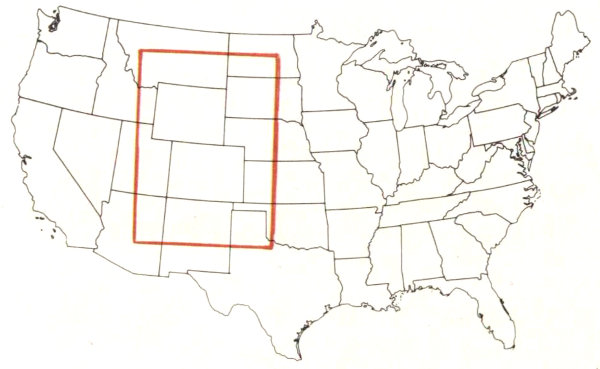
To reach the park from Scottsbluff, Nebraska, take Nebr. 26 west to Mitchell, then Nebr. 29 north to the park. From Fort Robinson, Nebraska, take Nebr. 20 west to Harrison, then Nebr. 29 south to the park.
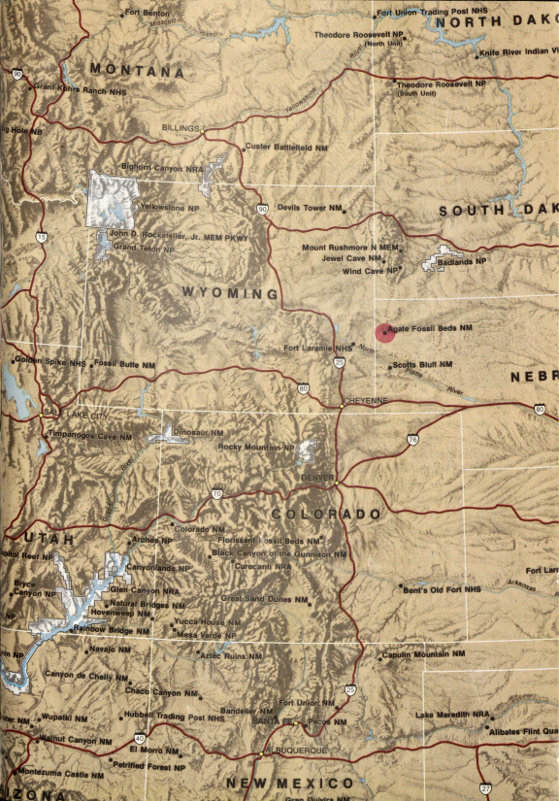
Plains states
High-resolution Map
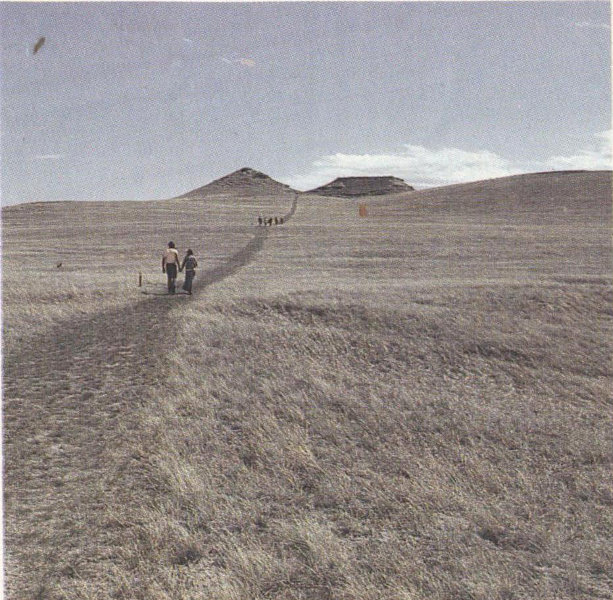
The trail from the visitor center takes you across the Niobrara River, up University Hill to the fossil layer, then to the fossil exhibit on Carnegie Hill, and back to the visitor center. The walk takes about one hour.
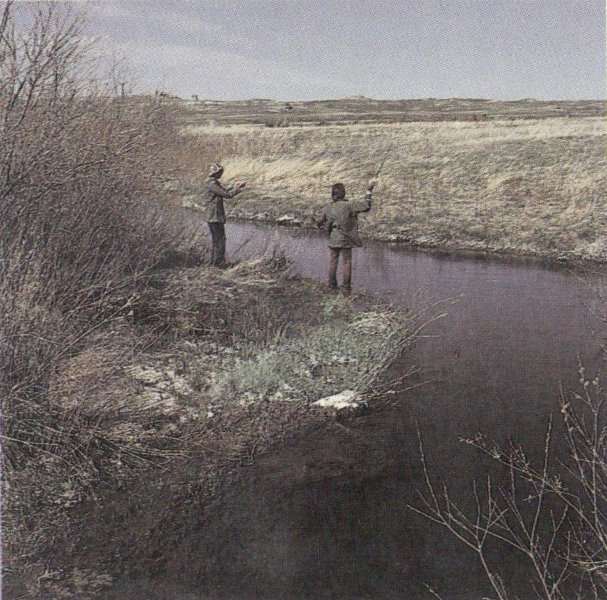
Two fishermen try their luck in the Niobrara.
To ensure your safety and to protect the park’s natural and historical resources, several regulations have been established by the National Park Service. Collecting of fossils, rocks, plants, or other objects is not permitted. Please be sure to leave everything as you find it along the trails and throughout the park for others to enjoy. If you have any questions about park regulations and policies, please ask the staff. The rangers are here to help you and to enforce the regulations.
Though snakes are not prevalent, be sure to watch for rattlesnakes as you walk about through the park, along the trails, and near the exhibits at Carnegie and University Hills. Avoid them if you see them, but do not harm them. As a general rule it is best to keep a good distance from any wildlife you see, not only to protect yourself and your children, but to avoid frightening or hurting the animal. It is best to observe wildlife at a safe distance with field glasses. While walking about the park, do not take chances by climbing on loose rock, or going into unauthorized areas, and do not let your children go beyond your control. Park your vehicle in authorized places and observe the normal rules of road safety and courtesy while you are in the park, and when entering and leaving it.
One of the joys of visiting the national parks, author Freeman Tilden once said, is having an unexpected, provocative experience. You go to a park to see or do one thing, and you come across something else that strikes your fancy as well. Tilden called it serendipity. At Agate Fossil Beds National Monument, one such experience might be birdwatching. In this piece, Doris B. Gates writes of her annual bird surveys in this area.
In western Nebraska the northern part of the Great Plains ends at the Pine Ridge, an escarpment circling from Wyoming across Nebraska’s north edge and winding into South Dakota. A major grass of this mixed prairie is little bluestem, Nebraska’s state grass, whose rusty-red hue in fall and winter gives much of the state its characteristic color.
These plains are rarely broken by cultivation and only a few houses with their few trees break the landscape. The land’s major change comes where the Niobrara River, here little more than a narrow creek, cuts a valley whose rock outcroppings provide homes for rock wrens, chipmunks, and bushy-tailed wood rats better known as pack or trade rats.
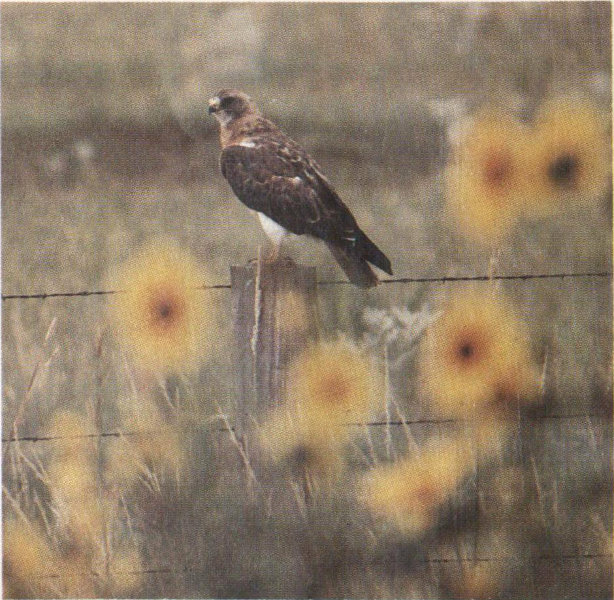
Swainson’s hawk
Here, since 1967, near Agate Fossil Beds National Monument, my partner and I have taken part in the annual Breeding Bird Survey for the U.S. Fish and Wildlife Service. Part of one of our survey routes, Highway 29, crosses the monument’s west end. We know the area—in June at least—quite intimately, when there is nothing quite so beautiful as a sunrise over these flower-dotted, green-grassed rolling hills along the Niobrara.
We go many kilometers and make many bird counting stops, then we drop into the little valley where the Niobrara flows and suddenly we hear and see birds in such rapid succession that we have difficulty getting them all named in the three minutes allowed us under the survey rules. Actually, three stops are influenced by the river: on the south edge we have found a common nighthawk, a lark sparrow, and a Say’s phoebe; on the north end the rock wren sings its un-wrenlike song. Near the bridge, where a narrow belt of shrubs and trees—mostly willows—hugs the river, we have logged the following: common flicker, a red-headed woodpecker, eastern and western kingbirds, western wood peewees, a blue jay, black-capped chickadees, house wrens, a brown thrasher, robins, yellow warblers, black-billed magpies, common grackles, black-headed grosbeaks, American goldfinches, and the non-native house sparrow and starling. Only once did we see or hear a black-billed cuckoo.
continues on page 85
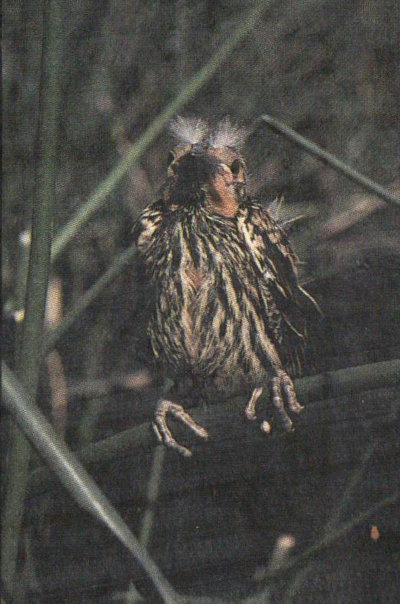
Red-winged blackbird chick
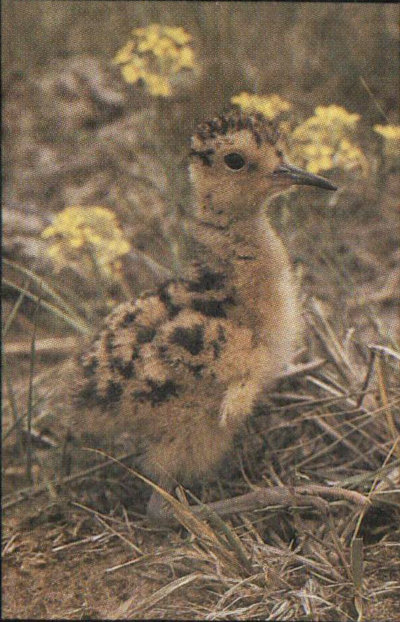
Long-billed curlew chick
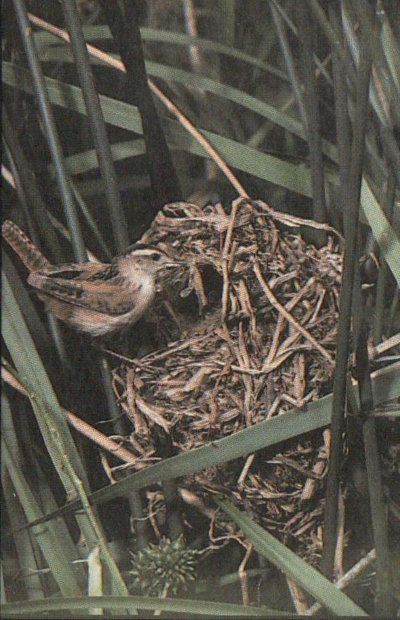
Long-billed marsh wren
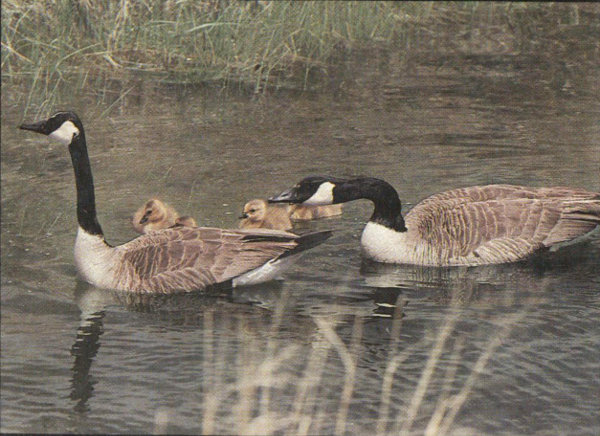
Canada geese
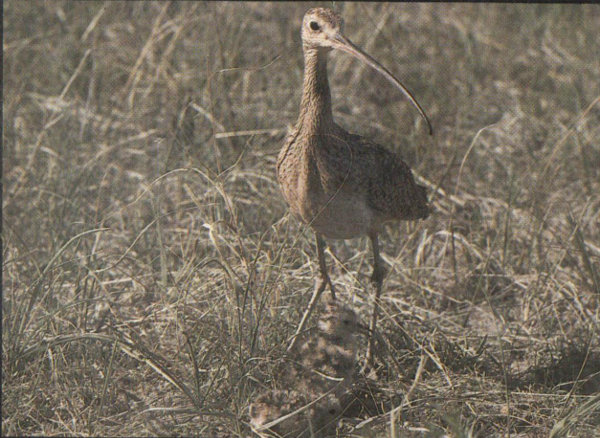
Long-billed curlew male
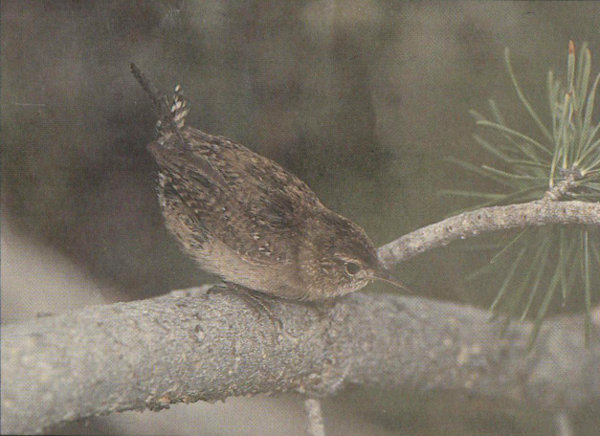
House wren
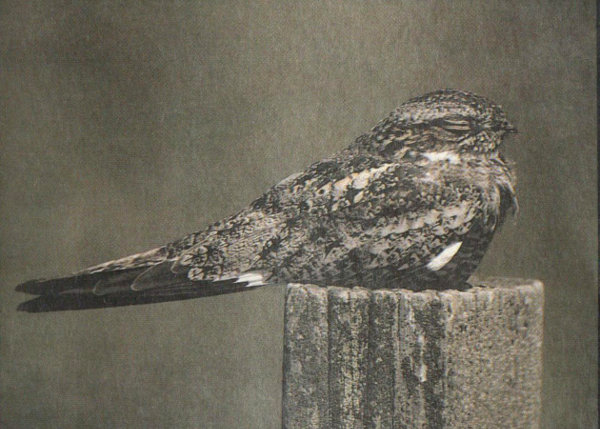
Nighthawk
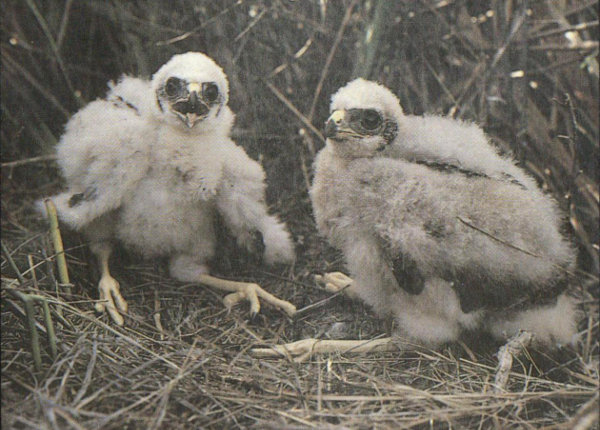
Marsh hawk chicks
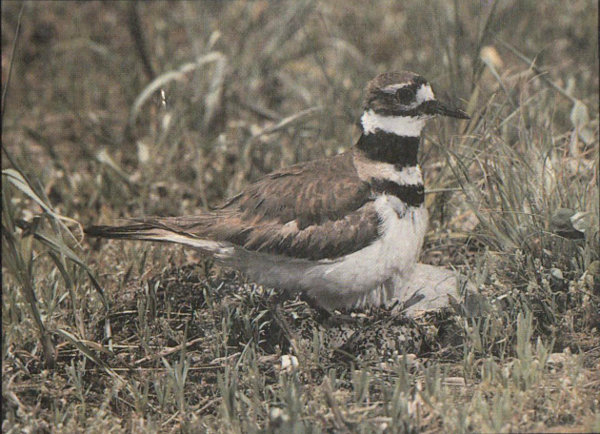
Killdeer
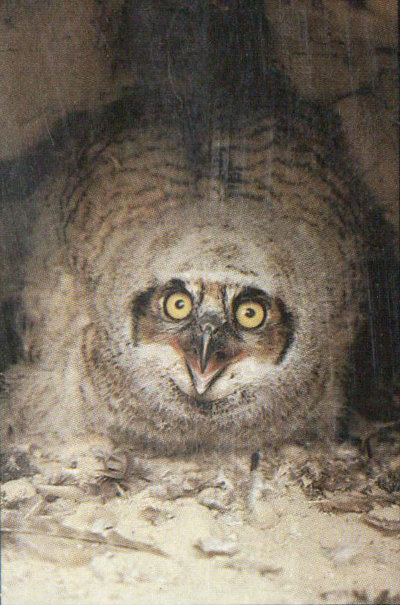
Great horned owl
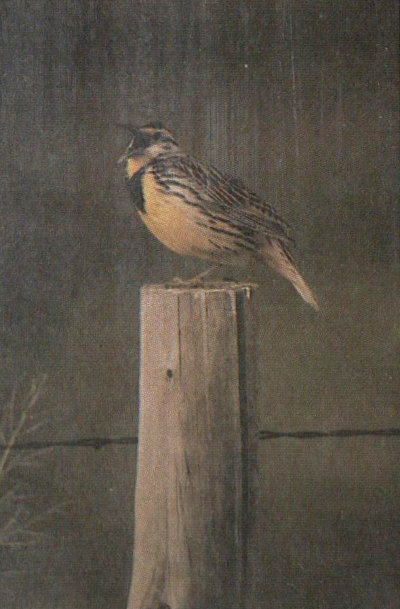
Western meadowlark
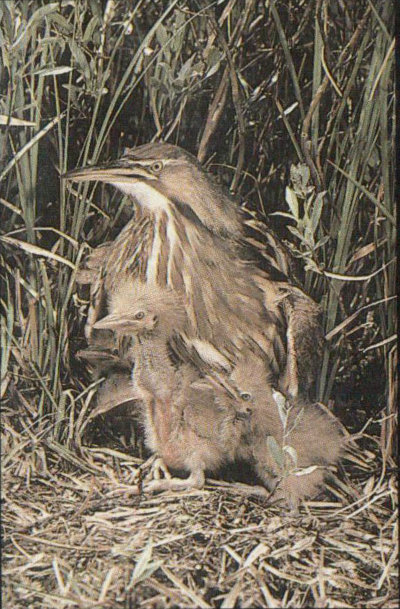
American bittern
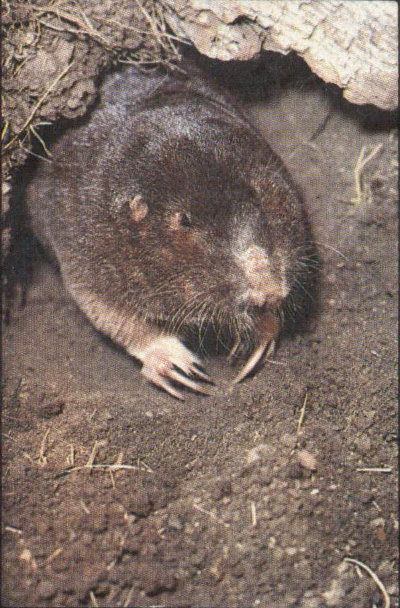
Pocket gopher
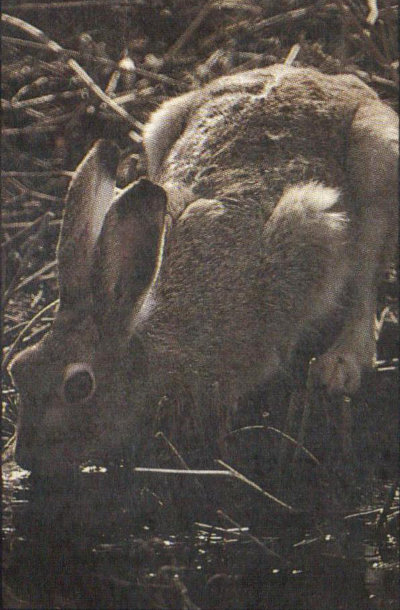
Jackrabbit
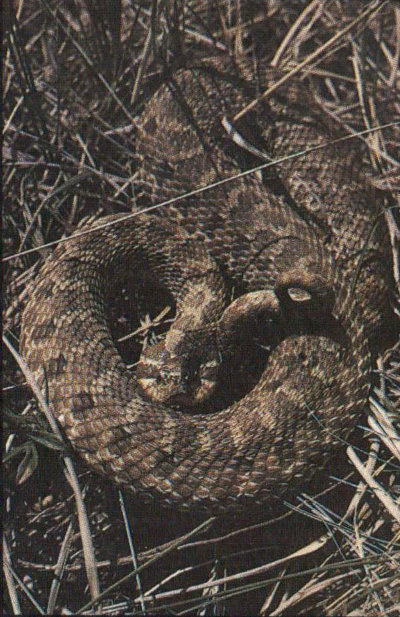
Hognose snake
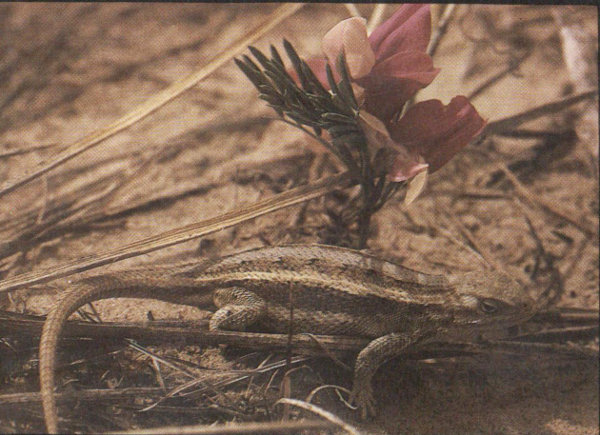
Fence lizard
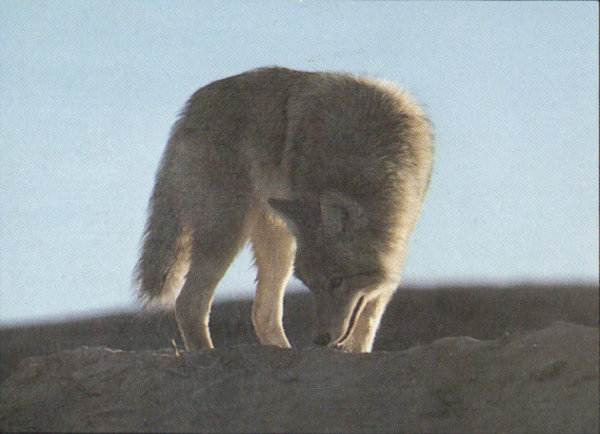
Coyote
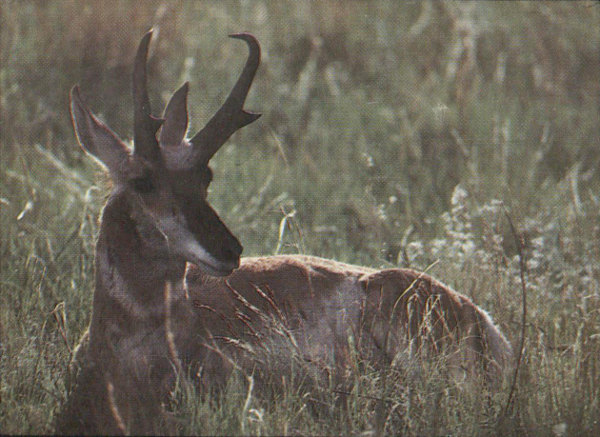
Pronghorn
If we stop and peer into a large culvert under the highway we may scare out a cloud of cliff swallows whose mud nests are stuck on culvert walls. Barn and rough-winged swallows are more rarely seen—usually near the Agate buildings.
Near scattered farmhouses we may see logger-head shrikes; by one water tank we usually find a few killdeer. These and such birds as the long-billed curlew, upland sandpipers, and sharp-tailed grouse break the near monotony of such prairie birds as western meadowlarks (Nebraska’s state bird), lark buntings, horned larks, and chestnut-collared longspurs. Lark buntings line the utility wires, taking off to sing their territorial songs, and descending with butterfly-like motions.
Hawks are here—red-tails, Swainson’s, ferruginous, marsh, and the little American kestrel—but in small numbers. We search long rows of fence posts for a burrowing owl and occasionally see one. Great-horned owls frequent tall cottonwood trees around the Agate ranch buildings. This is also the country of turkey vultures, golden eagles, and prairie falcons, but we have not been lucky enough to see them yet.
Mammals are more elusive. Cattle pasture conspicuously on land formerly claimed by the buffalo (bison). We see pronghorns each year. A lone coyote is the only other relatively large mammal we have logged. Check a good mammal book and you will appreciate what lives here largely invisible to the untrained eye: shrews, moles, bats, cottontails and two kinds of jackrabbits, pocket gophers, prairie dogs, kangaroo rats, voles, several kinds of mice, two kinds of ground squirrel, muskrats, beaver, raccoons, minks, badgers, longtailed weasels, two kinds of skunks, occasional porcupines and bobcats, white-tailed deer, and mule deer. Consider yourself lucky if you see the swift fox, mountain lion, and the rare black-footed ferret.
Life abounds here in other forms less noticeable to eyes trained on the Breeding Bird Survey: various species of amphibians, reptiles, fish, and the numerous insects associated with grasslands. We hear perhaps too much about rattlesnakes—western Nebraska has only the prairie rattler, whose numbers are now much reduced. Other snakes include western hognosed, blue racer, bullsnake, and the plains, wandering, and red-sided garter snakes.
Many museums throughout the world have displays of fossils from the Agate Fossil Beds. Very few of them actually collected their own material. Museum curators are dedicated “horse traders” and fossil-swapping is part of the business. When museums such as the Carnegie Museum of Pittsburgh or the American Museum of Natural History in New York make collections like the ones made at Agate earlier in this century, they usually have some trading stock left over after completing their study collections and exhibits. They then can trade an extra Menoceras slab, for example, for a dinosaur skeleton from some faraway corner of the Earth.
At several museums in this country you can see mounted skeletons of several animals found at Agate, along with Menoceras slabs (sections of rock with the bones still imbedded) or models and dioramas of Agate specimens. To the right are listed, in order of proximity to the park, some of the museums and their specimens from Agate.
The United States Museum of Natural History, Smithsonian Institution, has many fossils that depict the life of the most recent 65 million years and several murals by artist Jay H. Matternes showing the life of each of the epochs. The Miocene mural, reproduced on pages 20-21 of this handbook, is among these reconstructions. It depicts ancient life around what is today known as Agate Fossil Beds National Monument.
| The Trailside Museum Fort Robinson, Nebraska 69339. | |
 | Menoceras slab, skeleton, and restoration |
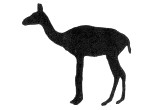 | Stenomylus skeleton on a slab, and a prepared limb |
| Palaeocastor in a Daemonelix Palaeocastor in a plaster cast | |
Museum of Geology, South Dakota School of Mines and Technology Rapid City, South Dakota 57701. | |
 | Menoceras slab, beautifully prepared |
The Geological Museum University of Wyoming, Laramie, Wyoming 82070. | |
 | Menoceras, mounted skeleton |
 | Stenomylus slab containing most of a skeleton |
University of Nebraska State Museum 101 Morrill Hall, 14th and U Streets, Lincoln, Nebraska 68508. | |
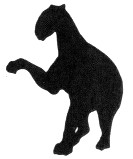 | Moropus, mounted skeleton |
| Palaeocastor skeleton in a Daemonelix; also, two other Daemonelix | |
 | Menoceras slab |
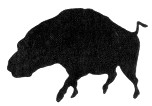 | Dinohyus skeleton |
 | Stenomylus, a group of skeletons |
Field Museum of Natural History Roosevelt Road at Lake Shore Drive, Chicago, Illinois 60605. | |
 | Menoceras slab |
 | Moropus skeleton |
The University of Michigan Exhibit Museum 1109 Geddes Rd., Ann Arbor, Michigan 48104. | |
 | Menoceras slab and mounted skeleton |
 | Dinohyus eating dead Menoceras, a diorama |
 | Stenomylus skeleton and model |
Carnegie Museum 4400 Forbes Ave., Pittsburgh, Pennsylvania 15213. | |
 | Promerycochoerus slab |
 | Menoceras slab and mounted skeleton |
 | Moropus, mounted skeleton |
 | Dinohyus, mounted skeleton |
 | Stenomylus, three skeletons mounted in a group |
The American Museum of Natural History Central Park West and 79th St., New York, New York 10024. | |
 | Moropus skeleton |
 | Menoceras slab and skulls, one used in a sequence showing collecting and preparation techniques |
 | Dinohyus skull |
 | Stenomylus, nine skeletons and a reconstruction of the group in life |
Museum of Comparative Zoology Harvard University, Oxford Street, Cambridge, Massachusetts 02138. | |
 | Menoceras slab |
 | Dinohyus skeleton |
 | Stenomylus skeleton |
Several fossil sites in the United States are under the protection of the National Park Service. Besides Agate, the major ones are:

Badlands
Prominent deposits from the Oligocene Epoch, predecessor to the Miocene, combine with a rugged, eroded landscape and abundant wildlife to make Badlands a park where the natural processes of the past combine with those of today. The National Park Service maintains a Fossil Exhibit Trail at Badlands and presents fossil cleaning demonstrations. Prominent fossils are those of ancient camels, giant pigs, sabertooth cats, Protoceras, and Brontotheres. Mailing address: P.O. Box 6, Interior, SD 57750.
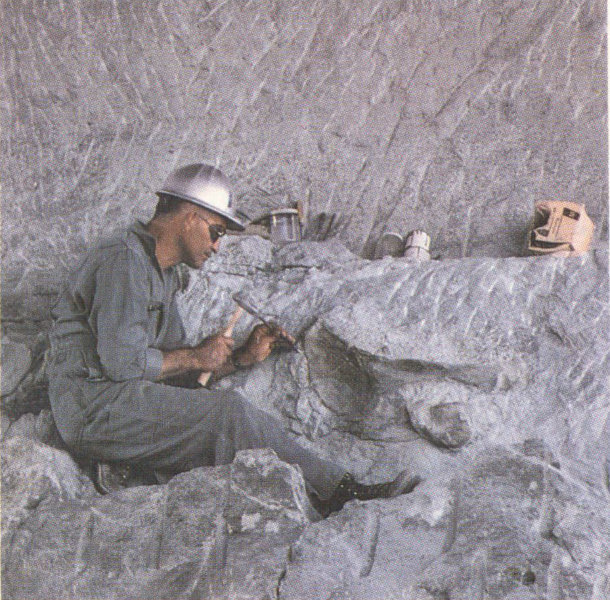
Dinosaur
The late Jurassic muds and sands of the Morrison Formation have been a major source of dinosaur bones for more than a century. Steeply tilted strata near Vernal, Utah, were the source of tons of bones for the Carnegie Museum of Pittsburgh. This quarry site became the nucleus of Dinosaur National Monument. The bone-bearing stratum has been exposed by careful excavation, so that bones and partial skeletons of numerous dinosaurs are exposed in high relief. The entire quarry face is covered by a glass-walled structure that forms a large gallery. Mailing address: 4545 E. Hwy. 40, Dinosaur, CO 81610.
This site has long been famous for its fossils of insects and plants preserved in fine-grained sediments. Specimens of Brontothere indicate an Eocene age for the deposits. Mailing address: P.O. Box 185, Florissant, CO 80816.
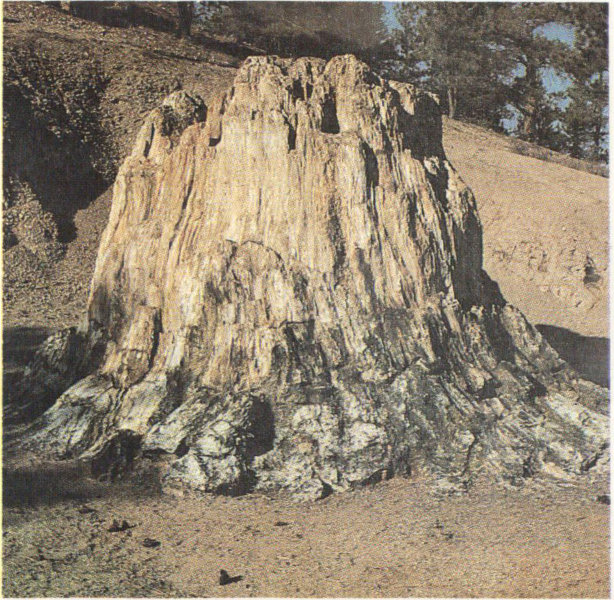
Florissant
Within the strata of this rock remnant of an ancient lake is one of the most extensive concentrations of fossilized freshwater fish known to science. The site is about 18 kilometers (11 miles) west of Kemmerer, Wyoming. Mailing address: P.O. Box 592, Kemmerer, WY 83101.
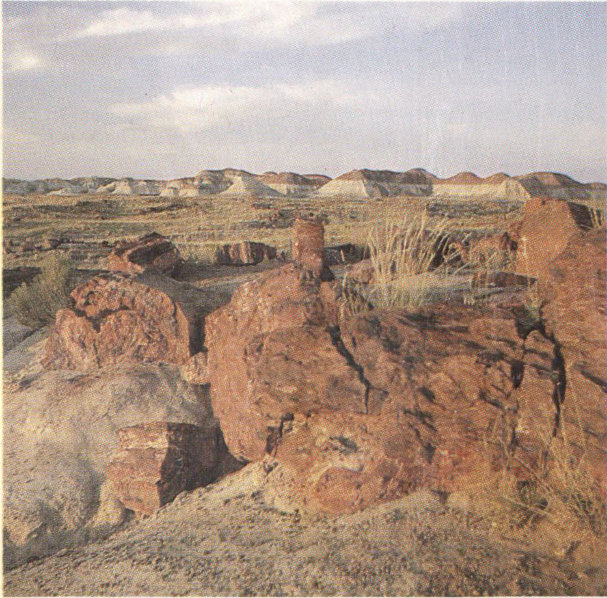
Petrified Forest
Here in the Late Triassic Chinle Formation are widespread deposits of petrified logs. Some are nearly 2 meters in diameter and 60 meters long (6.5 by 197 feet). Preserved in bright colors of opal and other minerals, the most common trees are relatives of the living monkey puzzle or Hawaiian star pine. Paleontologists believe many of the logs floated to the area in Triassic rivers and became stranded. In the museum are displays of various fossil plant species and animal fossils from the same deposits. Mailing address: P.O. Box 2217, Petrified Forest National Park, AZ 86028.
With a total of about 5,700 hectares (14,100 acres) in several noncontiguous units in north-central Oregon, this park provides an extensive record of Earth history dating back at least 37 million years. Plant and animal fossils are present in great variety. Mailing address: HCR 82, Box 126, Kimberly, OR 97848.
Within the banks of the Snake River are preserved the last vestiges of late Pliocene life before the Ice Age and modern flora and fauna appeared. Mailing address: P.O. Box 570, Hagerman, ID 83332.
While you’re in the Agate Fossil Beds area, why not see some other sites in the National Park System? These parks offer a variety of experiences from frontier history presentations to caving.
Badlands National Park is 97 kilometers (60 miles) southeast of Rapid City, South Dakota. This wonderland of bizarre, colorful spires and pinnacles, massive buttes, and deep gorges is open all year, though blizzards may temporarily block roads in the winter. Campfire programs and guided nature walks are presented. Backpackers will enjoy the park’s wilderness area. The park has a herd of about 300 bison and some prairie dog towns. Mailing address: P.O. Box 6, Interior, SD 57750.
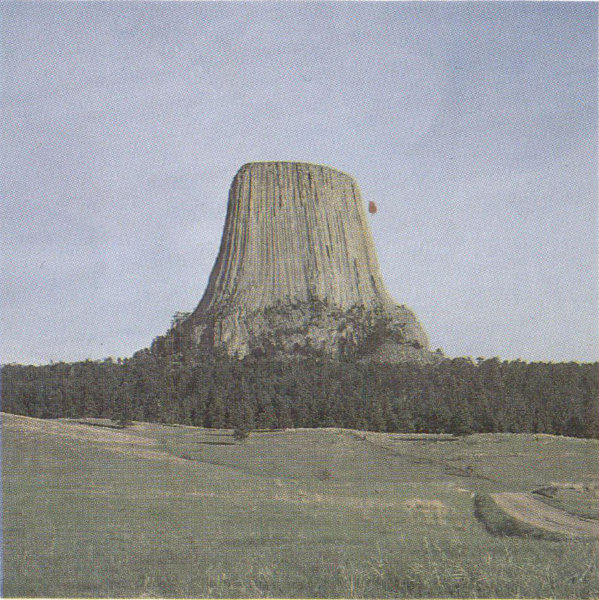
Devils Tower
Devils Tower National Monument is 47 kilometers (29 miles) northwest of Sundance, Wyoming. Known as Mato Tipila (Bear Lodge) to the Lakota, this towering landmark looms over the Belle Fourche River in the northeast corner of Wyoming. Here the Black Hills meet the plains grasslands, and you will likely see prairie dogs, as well as other mammals and a variety of birds. The park is open all year. Mailing address: P.O. Box 10, Devils Tower, WY 82714.
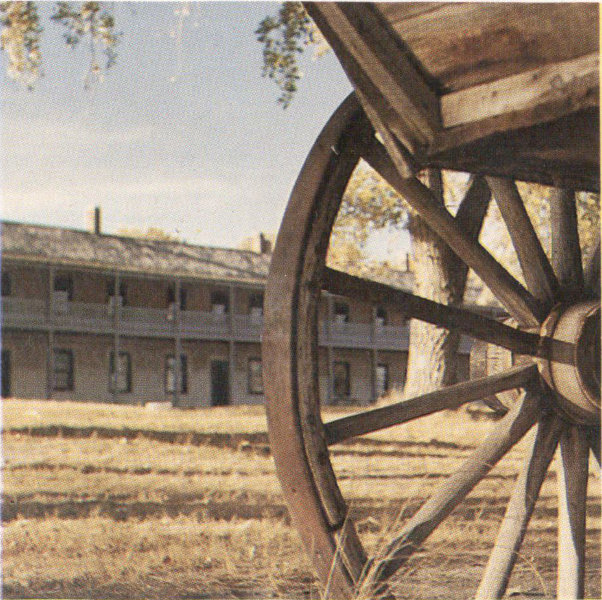
Fort Laramie
Fort Laramie National Historic Site is 5 kilometers (3 miles) southwest of Fort Laramie, Wyoming. The first fort on the site was built in 1834 and soon became a lucrative center of the fur trade. The U.S. Army took over in 1849, using the fort to protect the Oregon Trail. The fort was abandoned by the Army in 1890. Several buildings are furnished as they would have been during the Army years of the 1870s and 1880s. The park is open all year. Mailing address: HC 72, Box 389, WY 82212.
Jewel Cave National Monument is located on U.S. 16, 24 kilometers (15 miles) west of Custer, South Dakota. The cave’s name comes from the myriads of jewel-like calcite crystals that adorn its walls. Tours are conducted daily from mid-May through September. Tours, if any, the rest of the year are irregular. Mailing address: RR 1, Box 60 AA, Custer, SD 57730.
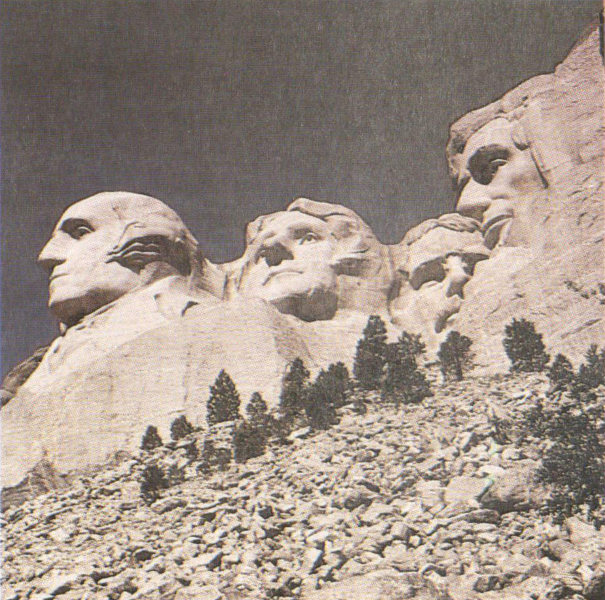
Mount Rushmore
Mount Rushmore National Memorial is 40 kilometers (25 miles) southwest of Rapid City, South Dakota. The mountain sculpture of Washington, Jefferson, Theodore Roosevelt, and Lincoln is best viewed under morning light. From June 1 to Labor Day the faces are illuminated at night. The park is open all year. Mailing address: P.O. Box 268, Keystone, SD 57751.
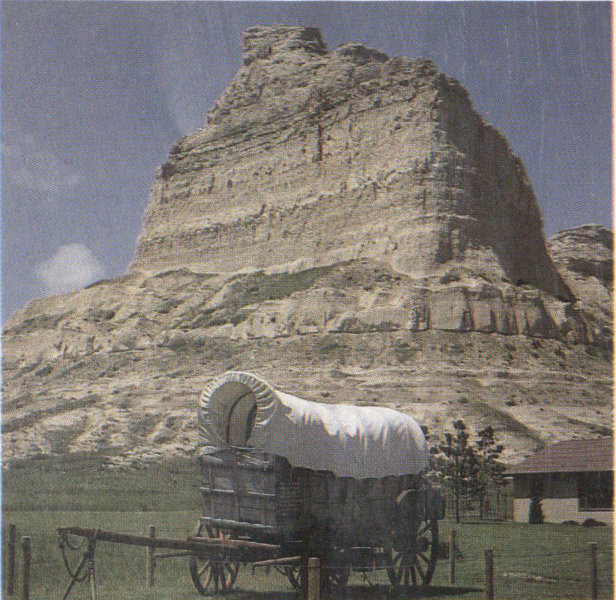
Scotts Bluff
Scotts Bluff National Monument is 8 kilometers (5 miles) southwest of Scottsbluff, Nebraska. This massive rock promontory rises 245 meters (800 feet) above the valley floor, and it served as a landmark to Indians, fur traders, and settlers traveling the Oregon Trail. It was named for a fur trapper, Hiram Scott, and has remained a symbol of the great overland migrations. The park is open all year. Mailing address: P.O. Box 27, Gering, NE 69341.
Wind Cave National Park is 16 kilometers (10 miles) north of Hot Springs in southwest South Dakota. Two worlds meet here: the underground world of the cave and the life of the surface prairie. The cave gets its name from the wind blowing into or out of the cave. Mailing address: RR 1, Box 190, Hot Springs, SD 57747.
By expanding your travel perimeter even farther beyond Agate Fossil Beds, you can take in these other National Park System sites.
Bighorn Canyon National Recreation Area straddles the Montana-Wyoming border, 67 kilometers (42 miles) from Hardin, Montana, and at Lovell, Wyoming. Access to boat ramps and campgrounds is from both ends of the long reservoir. Yellowtail Dam tours are given from Memorial Day to Labor Day. The visitor centers are open all year. Mailing address: P.O. Box 458, Fort Smith, Montana 59035.
Little Bighorn Battlefield National Monument is 24 kilometers (15 miles) south of Hardin, Montana. Here on June 25, 1876, Lt. Col. George Armstrong Custer and five 7th Cavalry companies attacked and were surrounded and killed by Indians. Mailing address: P.O. Box 39, Crow Agency, MT 59022.
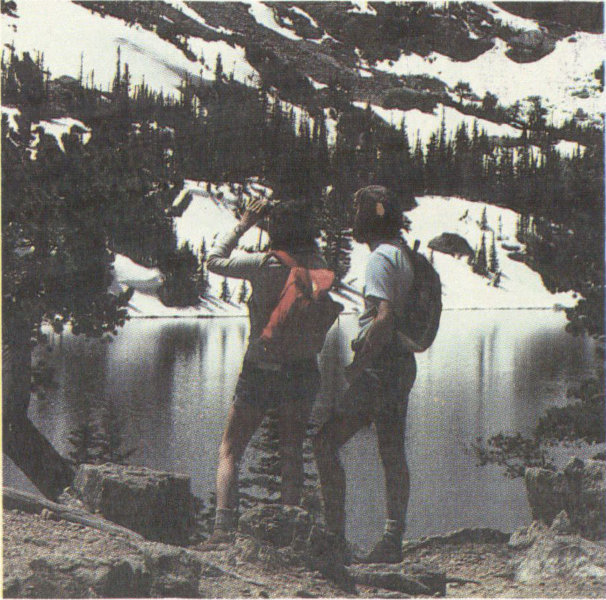
Rocky Mountain
Rocky Mountain National Park is northwest of Denver and about 3 kilometers (2 miles) west of the community of Estes Park, Colorado. The park is one of America’s most accessible mountainous areas. Trail Ridge, which crosses the Continental Divide, offers breathtaking views. Elk, mule deer, bear, cougar, and bighorn sheep roam mountain crags, meadows, and valleys. Mailing address: Estes Park, CO 80517.
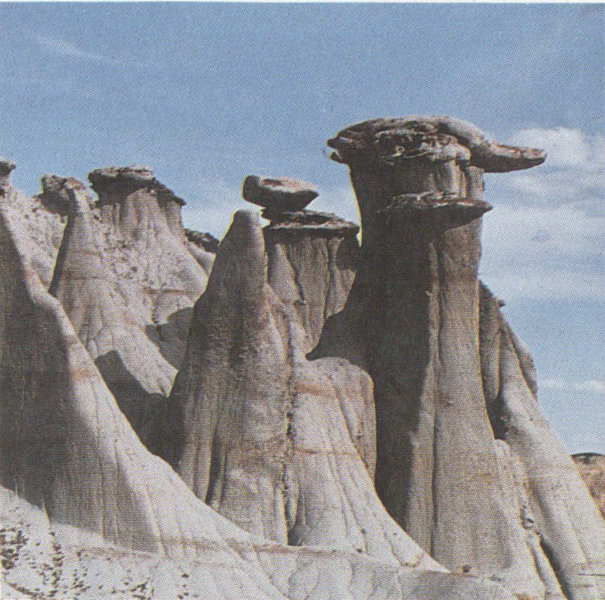
Theodore Roosevelt
Theodore Roosevelt National Park is on Interstate 94 at Medora, North Dakota. A separate unit is 90 kilometers (56 miles) north on U.S. 85. In these magnificantly colored badlands along the Little Missouri River Roosevelt had an open-range ranch and developed his practical conservation philosophy. Both units have campgrounds. Mailing address: P.O. Box 7, Medora, ND 58645.
Bartlett, Richard A., Great Surveys of the American West, University of Oklahoma Press, 1962.
Camp, Charles L., Earth Song: A Prologue to History, American West Publishing Co., 1970.
Colbert, Edwin H., Evolution of the Vertebrates, John Wiley and Sons, Inc., 1969.
Cook, Harold J., Tales of the 04 Ranch, University of Nebraska Press, 1968.
Cook, James H., Fifty Years on the Old Frontier, University of Oklahoma Press, 1980.
Gould, Stephen Jay, Ever Since Darwin: Reflections in Natural History, W. W. Norton and Co., 1977.
Howard, Robert West, The Dawn-seekers, Harcourt Brace Jovanovich, 1975.
Johnson, Kirk R. and Richard K. Stucky, Prehistoric Journey: A History of Life on Earth, Roberts Rinehart, 1995.
Lanham, Url, The Bone Hunters, Columbia University Press, 1973.
Laporte, Léo F., Evolution and the Fossil Record, W. H. Freeman Co., 1978.
Larson, Robert W., Red Cloud: Warrior-Statesman of the Lakota Sioux, University of Oklahoma Press, 1997.
Mason, Stephen F., A History of the Sciences, Collier Books, 1970.
Meade, Dorothy Cook, Heart Bags & Handshakes: The Story of the Cook Collection, National Woodlands Pub. Co., 1994.
Osborn, Henry F., Cope: Master Naturalist, Princeton University Press, 1931.
Paul, R. Eli, Autobiography of Red Cloud: War Leader of the Oglalas, Montana Historical Society Press, 1997.
Plate, Robert, The Dinosaur Hunters: Othniel C. Marsh and Edward D. Cope, McKay Co., 1964.
Raup, David M. and Steven M. Stanley, Principles of Paleontology, W. H. Freeman Co., 1978.
Romer, Alfred Sherwood, Vertebrate Paleontology, University of Chicago Press, 1966.
Schuchert, Charles and Clara Mae LeVene, O.C. Marsh: Pioneer in Paleontology, Yale University Press, 1940.
Numbers in italics refer to photographs, illustrations, charts, or maps.
A B C D E F G H I J K L M N O P Q R S T U V W X Y Z
The National Park Service expresses its appreciation to all those persons who made the preparation and production of this handbook possible. The Service also gratefully acknowledges the financial support given this handbook project by the Oregon Trail Museum Association, a nonprofit group that assists interpretive efforts at Agate Fossil Beds National Monument.
James R. and Laurie J. Macdonald, authors of “A Landscape Rich With Life” in Part 2, are paleontologists who live in Sunnyvale, California, and teach nearby.
Doris B. Gates, writer of “Birding Along the Niobrara” in Part 3, is a retired biology professor who lives in Chadron, Nebraska.
R.R. Donnelly & Sons Co. 79.
The mission of the Department of the Interior is to protect and provide access to our Nation’s natural and cultural heritage and honor our trust responsibilities to tribes. The National Park Service preserves unimpaired the natural and cultural resources and values of the National Park System for the enjoyment, education, and inspiration of this and future generations. The National Park Service cooperates with partners to extend the benefits of natural and cultural resource conservation and outdoor recreation throughout this country and the world.
Through the remains of animals long extinct, excavated here at this site, Agate Fossil Beds National Monument tells the story of the Miocene Epoch—the Age of Mammals—that occurred 5 to 23 million years ago. The scene on the front cover is from a mural by artist Jay H. Matternes that depicts animals of the Early Miocene.
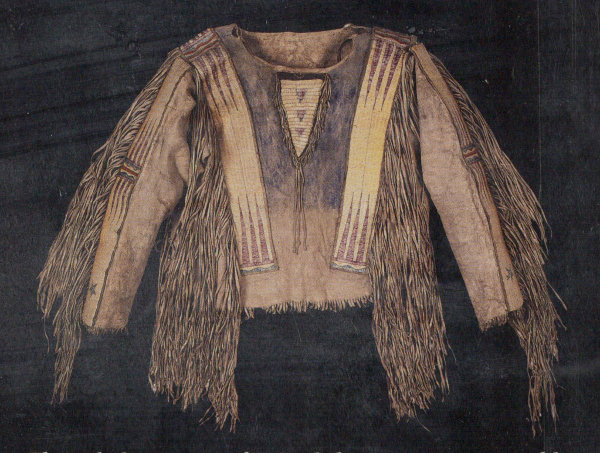
In addition to fossils, the park has an extensive collection of Plains Indian art and artifacts, such as this shirt that belonged to Red Cloud.